Practices to Awaken Shakti Energy
Awaken Shakti Energy now! by Asanas , Pranayama , Mudras and Bandhas, Meditation and Visualization, Yoga Nidra and Deep Relaxation, Rituals and Ceremonies, Diet and Nutrition, Sound Healing

In Hinduism, Shakti refers to the divine feminine energy or power that is considered the dynamic force behind all creation, preservation, and destruction in the universe. Shakti is often personified as the goddess and is the consort of Shiva, one of the principal deities in Hinduism. Together, Shiva (representing consciousness) and Shakti (representing energy) symbolize the balance of masculine and feminine energies in the cosmos.
Shakti is worshipped in various forms, including:
-
Durga - The warrior goddess who embodies strength and protection.
-
Kali - The fierce form of Shakti, representing destruction of evil and transformation.
-
Parvati - The gentle and nurturing aspect of Shakti, associated with love, fertility, and devotion.
-
Lakshmi - The goddess of wealth, prosperity, and abundance.
-
Saraswati - The goddess of knowledge, wisdom, and the arts.
Shakti energy is also associated with Kundalini, a dormant spiritual energy believed to reside at the base of the spine. Through practices like yoga and meditation, this energy can be awakened and channeled upward through the chakras, leading to spiritual enlightenment.
In essence, Shakti represents the active, creative, and transformative power of the universe, and her worship is central to many Hindu traditions, particularly in Shaktism, a major sect that venerates the goddess as the supreme being.
Let's embark on a transformative journey into the heart of Shakti energy, the divine feminine force that fuels creation, transformation, and spiritual awakening. This article offers profound insights into harnessing this primal energy through yoga, meditation, sound healing, rituals, and nutrition. Discover how to awaken your dormant potential, balance your chakras, and align with the rhythms of nature. Whether you're seeking emotional healing, spiritual growth, or physical vitality, this guide provides the tools to connect with your inner Shakti and unlock a life of harmony, creativity, and empowerment.
What is Shakti Energy?
Shakti is the primordial cosmic energy that flows through all living beings, representing the dynamic, creative, and nurturing aspects of the universe. In yogic and Tantric traditions, Shakti is often depicted as a coiled serpent at the base of the spine, waiting to be awakened. When activated, this energy rises through the chakras, leading to self-realization, spiritual enlightenment, and a deep connection to the divine. Shakti is not just a concept—it is a living force within you, ready to transform your life when awakened and balanced. Dive into this article to explore how you can tap into this infinite source of power and wisdom.
Moving forward to awaken Shakti Energy in you:-
Shakti Energy Awakening by following practices - Yoga Asanas, Pranayama, Mudras, Bandhas, Meditation, Visualization, Chakra Balancing, Yoga Nidra, Relaxation, Rituals, Ceremonies, Diet, Nutrition, Herbs, Sound Healing, Vibrations, Frequencies, Emotional Release, Spiritual Growth, Holistic Well-being, Energy Channeling, Breath Control, Stress Reduction, Self-Awareness, Nature’s Cycles, Divine Feminine, Creativity, Power, Healing, yoga shakti.
YOGAKSHTI - STRENGTH IN YOU
1. Asanas (Postures)
Yoga asanas are integral to awakening Shakti energy, fostering physical health, emotional balance, and spiritual growth. Below is an expanded exploration of foundational poses, dynamic sequences, advanced asanas for energy channeling, and chakra-specific postures.
Foundational Poses
Foundational poses are essential for establishing stability and focus in yoga practice. They prepare the body for deeper postures and facilitate the flow of prana (life force energy).
-
Padmasana (Lotus Pose):
Padmasana is a classic meditative posture where the legs are crossed with each foot resting on the opposite thigh. This pose enhances focus, balances energy, and prepares the body for meditation by creating a stable base.-
Variations:
-
Half Lotus Pose: A beginner-friendly version where one foot rests on the opposite thigh while the other leg remains on the ground.
-
Bound Lotus Pose: An advanced variation where the hands reach behind the back to hold the toes, deepening the stretch.
-
-
Benefits:
-
Opens the hips and increases flexibility in the knees and ankles.
-
Strengthens the spine, promoting better posture.
-
Calms the mind and reduces stress, making it ideal for meditation practices.
-
-
Precautions: Avoid forcing the legs into position to prevent knee injuries. Use props like cushions for support if needed.
-

-
Vajrasana (Thunderbolt Pose):
Vajrasana is a kneeling pose that symbolizes strength and invincibility, as its name suggests in Sanskrit ("vajra" meaning thunderbolt). It is particularly beneficial for digestion and is one of the few poses that can be practiced immediately after eating.-
Variations:
-
Reclined Vajrasana (Supta Vajrasana): This involves leaning back onto the floor while maintaining the kneeling position, creating a deeper stretch in the thighs and abdomen.
-
Vajrasana with Arms Behind: A variation where arms are clasped behind the back to open up the chest and shoulders further.
-
-
Benefits:
-
Improves digestion by stimulating abdominal organs.
-
Strengthens pelvic muscles and alleviates menstrual discomfort.
-
Enhances spinal alignment and posture.
-
-

-
Bhujangasana (Cobra Pose):
This gentle backbend mimics a cobra lifting its hood and is excellent for opening up the chest and strengthening spinal muscles. Bhujangasana is often included in Sun Salutations or practiced independently to prepare for deeper backbends.-
Variations:
-
Low Cobra Pose: Keeps elbows bent, reducing strain on the lower back while focusing on spinal lengthening.
-
High Cobra Pose: Involves straightening the arms to deepen the backbend, engaging more muscles in the spine and core.
-
Fingertip Cobra: A variation where only fingertips touch the mat to reduce wrist strain while increasing back strength.
-
-
Benefits:
-
Stimulates Manipura Chakra (solar plexus), enhancing vitality and confidence.
-
Relieves lower back pain by strengthening spinal muscles.
-
Opens up chest muscles, improving respiratory function.
-
-

Dynamic Sequences
Dynamic sequences involve flowing movements synchronized with breath, creating a rhythmic practice that awakens Shakti energy.
-
Shakti Vinyasa:
Shakti Vinyasa is a fluid sequence designed to awaken feminine energy through rhythmic movements and breathwork. It often incorporates hip-opening poses to release stored emotions and energy blockages.-
Components: Includes variations of Sun Salutations combined with poses like Goddess Pose (Utkata Konasana) to enhance flexibility and strength.
-
Benefits: Boosts flexibility, energizes the body, aligns chakras, and promotes emotional release.
-

-
Trataka Flow:
Trataka Flow combines physical movement with focused gaze meditation (Trataka). It involves transitioning between poses while maintaining a steady gaze at a candle flame or fixed point.-
Techniques: Perform slow transitions between poses like Warrior (Virabhadrasana) or Tree Pose (Vrikshasana) while focusing on a flame or object to enhance concentration.
-
Benefits: Improves mental clarity, enhances inner awareness, strengthens focus, and calms an overactive mind.
-

Advanced Asanas for Energy Channeling
Advanced asanas stimulate specific chakras and channel energy throughout the body.
-
Sirsasana (Headstand): Known as "The King of Asanas," Sirsasana reverses blood flow to stimulate Sahasrara Chakra (crown chakra). This inversion improves brain function by increasing oxygen supply to brain cells while aligning subtle energies in the body.

-
Halasana (Plow Pose): This pose stretches the spine deeply and activates Vishuddha Chakra (throat chakra), promoting better communication skills and self-expression.

-
Dhanurasana (Bow Pose): By arching into a bow shape, this pose opens up Manipura Chakra (solar plexus), enhancing confidence and willpower.

-
Karnapidasana (Ear Pressure Pose): Compresses ear regions to reduce external distractions, facilitating inward focus.
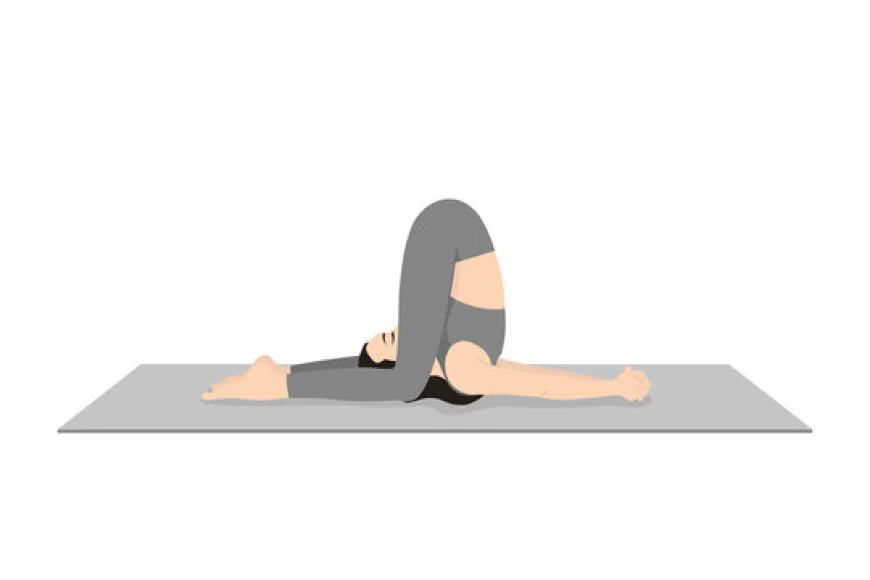
Chakra-Specific Poses
Each chakra corresponds to specific physical regions of the body. Practicing chakra-specific poses helps balance these energy centers.
-
Root Chakra (Muladhara):
-
Mountain Pose (Tadasana): Grounds energy by stabilizing posture.
-
Warrior Pose I (Virabhadrasana I): Promotes strength and stability.
-
Garland Pose (Malasana): Opens hips while grounding energy.
-
-
Sacral Chakra (Svadhisthana):
-
Butterfly Pose (Baddha Konasana): Opens hips, enhancing creativity.
-
Goddess Pose (Utkata Konasana): Strengthens pelvic muscles while releasing emotional tension.
-
-
Solar Plexus Chakra (Manipura):
-
Boat Pose (Navasana): Strengthens core muscles, building personal power.
-
Twisting Chair Pose (Parivrtta Utkatasana): Detoxifies internal organs while stimulating digestive fire.
-
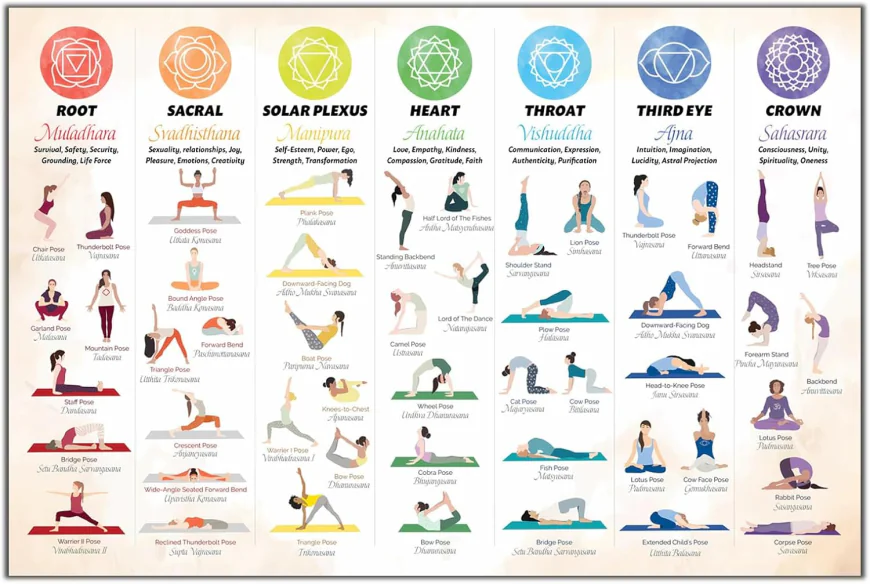
-
Heart Chakra (Anahata):
-
Camel Pose (Ustrasana): Opens up chest muscles to enhance compassion.
-
Bridge Pose (Setu Bandhasana): Stimulates heart energy flow.
-
-
Throat Chakra (Vishuddha):
-
Fish Pose (Matsyasana): Opens throat region for better communication.
-
Plow Pose (Halasana): Activates Vishuddha Chakra through compression.
-
-
Third Eye Chakra (Ajna):
-
Child’s Pose with Forehead Resting: Enhances intuition by stimulating this chakra.
-
-
Crown Chakra (Sahasrara):
-
Corpse Pose (Savasana) with visualization of light at crown enhances spiritual connection.
-
This detailed breakdown demonstrates how asanas serve as tools not only for physical fitness but also for emotional release, mental clarity, and spiritual awakening. Each posture contributes uniquely to activating Shakti energy within practitioners through targeted movements that align chakras while fostering harmony between body and mind.
2. Pranayama (Breath Control)
Pranayama, the practice of controlled breathing, is a cornerstone of yogic discipline and serves as a powerful tool to regulate energy, cleanse the body, and calm the mind. It is much more than a physical exercise; pranayama is a gateway to accessing and harmonizing prana, the vital life force that flows through the nadis (subtle energy channels) in the body. Various pranayama techniques have distinct benefits, ranging from energizing the body to purifying the mind. Below is an in-depth exploration of pranayama techniques, breathwork for nadis purification, breath retention practices, and breathwork for emotional release.
Techniques
Pranayama techniques are designed to balance the body’s energies and enhance physical, mental, and spiritual well-being. Among these, Bhastrika, Kapalabhati, and Nadi Shodhana are some of the most widely practiced forms.
-
Bhastrika Pranayama (Bellows Breath):
Bhastrika Pranayama is a heating technique that mimics the action of bellows fanning a fire. This practice involves rapid inhalation and exhalation that dynamically engages the diaphragm and abdominal muscles.-
How to Practice: Sit comfortably with an erect spine. Inhale deeply through your nose, allowing your abdomen to expand fully. Exhale forcefully through your nose while contracting your abdomen. Repeat this cycle rapidly for 10 breaths per round, gradually increasing to 5 rounds with breaks in between.
-
Benefits:
-
Energizes the body by stoking inner fire (agni), enhancing digestion and metabolism.
-
Clears energy blockages in nadis, promoting better pranic flow.
-
Balances kapha and vata doshas while calming aggravated pitta when practiced gently.
-
Improves oxygenation of blood and boosts energy levels.
-
-
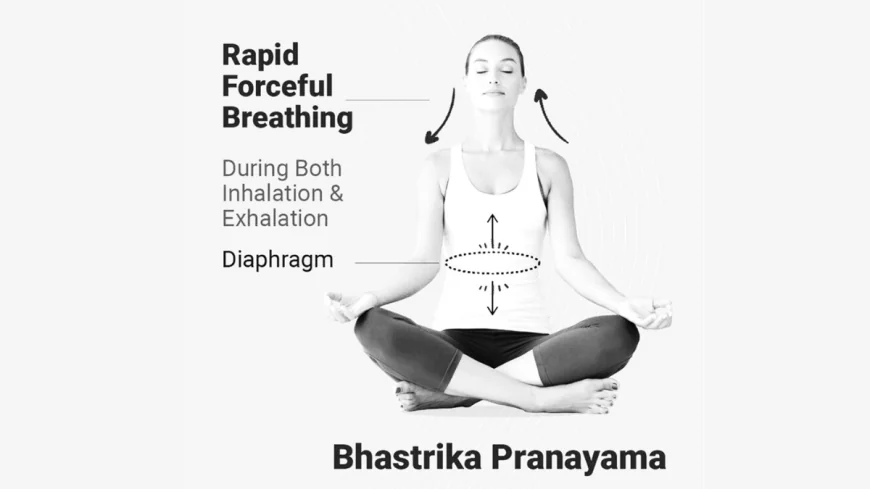
-
Kapalabhati Pranayama (Skull Shining Breath):
Kapalabhati is an invigorating breathing technique characterized by forceful exhalations and passive inhalations. The Sanskrit term kapala means "forehead," while bhati translates to "light" or "perception," symbolizing clarity of mind.-
How to Practice: Sit in a comfortable posture with your spine straight. Forcefully expel air through your nostrils while pulling your navel inward toward your spine. Allow passive inhalation as you release your abdominal muscles. Perform 20 repetitions per round, gradually increasing to 60 repetitions over time.
-
Benefits:
-
Detoxifies lungs and nasal passages by expelling stale air.
-
Sharpens mental focus and sensory perception by stimulating the brain’s frontal lobe.
-
Balances all three doshas (vata, pitta, kapha) and prepares the mind for meditation.
-
Tones abdominal muscles while improving digestion and appetite.
-
-
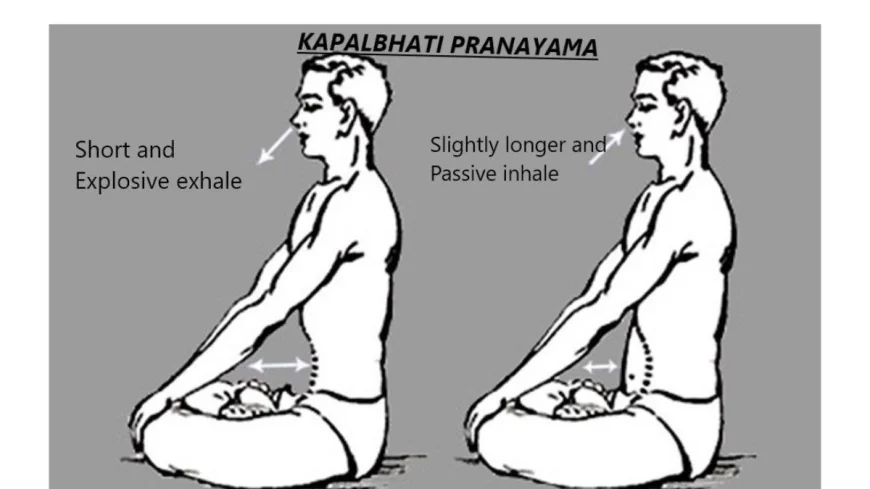
-
Nadi Shodhana Pranayama (Alternate Nostril Breathing):
Nadi Shodhana, also known as Anulom Vilom, is a calming practice that balances Ida (moon) and Pingala (sun) nadis to harmonize mental and physical energies. It involves alternate nostril breathing without any breath retention initially.-
How to Practice: Sit comfortably with an erect spine. Close your right nostril with your thumb and inhale deeply through your left nostril. Close your left nostril with your ring finger and exhale through your right nostril. Repeat this process by alternating nostrils for 9 rounds.
-
Benefits:
-
Purifies subtle energy channels (nadis) blocked by toxins or emotional stress.
-
Reduces stress, anxiety, and fatigue by calming the nervous system.
-
Improves cardiovascular function and enhances respiratory efficiency.
-
-

Breathwork for Nadis Purification
The nadis are subtle energy pathways in the body that can become blocked due to toxins, unhealthy lifestyles, or emotional trauma. Breathwork techniques like Alternate-Nostril Breathing (Anulom Vilom) and Fast-Paced Breathing (Surya Bhedana) are particularly effective for clearing these channels.

-
Alternate-Nostril Breathing (Anulom Vilom): This practice is synonymous with Nadi Shodhana but focuses specifically on cleansing nadis to restore energetic balance.
-
How it Works: By alternating breaths between the left nostril (Ida nadi) and right nostril (Pingala nadi), this technique balances cooling lunar energy with warming solar energy.
-
Benefits: Enhances mental clarity, improves focus during meditation, and reduces symptoms of stress-related disorders like insomnia or headaches.
-
-
Fast-Paced Breathing (Surya Bhedana): Also known as Sun Piercing Breath, Surya Bhedana activates solar energy in the body by emphasizing inhalation through the right nostril.
-
How to Practice: Close your left nostril using Vishnu Mudra while inhaling deeply through your right nostril. Retain the breath momentarily before exhaling slowly through your left nostril.
-
Benefits: Boosts vitality by stimulating sympathetic nervous system activity. Improves digestive fire (jatharagni) while promoting detoxification.
-
Breath Retention Practices
Breath retention (kumbhaka) is an advanced pranayama technique that involves holding the breath after inhalation (antara kumbhaka) or exhalation (bahya kumbhaka). This practice intensifies pranic flow within the body.

-
Kumbhaka Techniques:
-
Start by practicing simple breath retention after each inhalation for a few seconds.
-
Gradually increase retention duration as lung capacity improves.
-
-
Benefits:
-
Enhances concentration by directing prana toward higher chakras like Ajna (third eye) or Sahasrara (crown).
-
Strengthens respiratory muscles while improving oxygen utilization efficiency.
-
Activates dormant kundalini energy when combined with mudras or bandhas.
-
Breath for Emotional Release
Breathwork can also be used as a therapeutic tool for releasing stored emotions trapped within the body.


-
Deep Diaphragmatic Breathing:
-
Focus on slow inhalations that expand the diaphragm fully followed by prolonged exhalations.
-
This type of breathing activates the parasympathetic nervous system, reducing stress hormones like cortisol.
-
-
Benefits:
-
Releases suppressed emotions like anger or grief stored in cellular memory.
-
Promotes relaxation by calming overactive mental chatter.
-
-
Applications:
-
Useful during moments of emotional overwhelm or as part of mindfulness practices.
-
Pranayama serves as a bridge between physical health and spiritual awakening by regulating breath patterns that influence both physiological functions and subtle energetic flows within the body. Each technique offers unique benefits tailored to specific needs—whether it’s energizing through Bhastrika, detoxifying with Kapalabhati, balancing energies via Nadi Shodhana, or releasing emotions through diaphragmatic breathing—making pranayama an indispensable aspect of holistic well-being.
3. Mudras and Bandhas
Mudras and bandhas are powerful yogic practices that play a crucial role in channeling and regulating the flow of prana, or life energy, within the body. While mudras are symbolic gestures or positions of the hands, body, or fingers that influence energy pathways, bandhas are physical locks that seal and direct prana to specific areas of the body. Together, these practices amplify the effects of yoga and pranayama by enhancing energy flow, stabilizing the mind, and awakening dormant spiritual potential. Below is an in-depth exploration of key mudras, advanced mudras, bandhas for energy channeling, and the combined use of mudras and bandhas.
Key Mudras
Mudras are powerful tools for influencing the flow of prana through the nadis (subtle energy channels). They act as energetic switches that alter the state of consciousness and balance physical, emotional, and spiritual energies.
-
Yoni Mudra:
Yoni Mudra is a symbolic gesture representing the womb or source of creation. It is deeply connected to feminine energy and is often used to calm the mind and enhance inner awareness.-
How to Practice: Sit in a comfortable meditative posture. Interlace your fingers with palms facing inward, leaving the index fingers and thumbs free to form a diamond shape. Place this shape near your lower abdomen.
-
Benefits:
-
Symbolizes feminine energy and helps practitioners connect with their creative potential.
-
Calms mental agitation by focusing attention inward.
-
Enhances concentration during meditation practices.
-
-
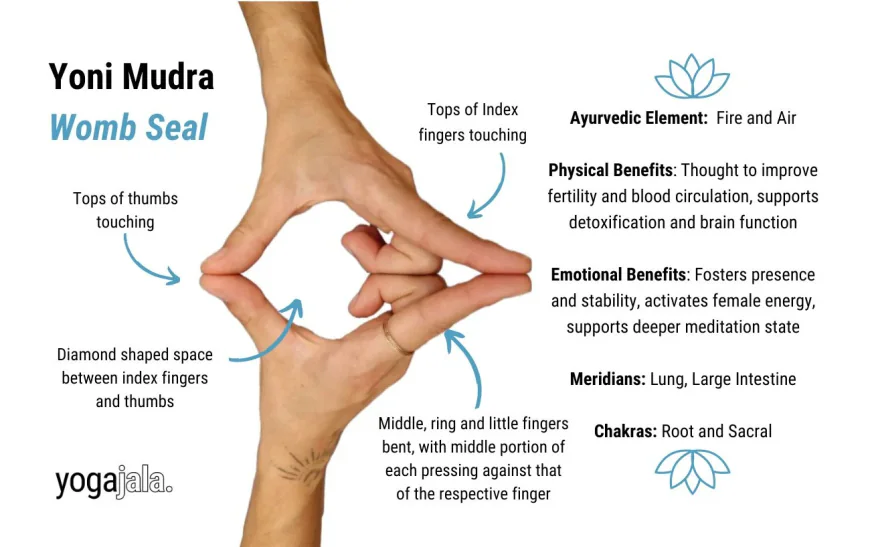
-
Shakti Mudra:
Shakti Mudra is named after Shakti, the divine feminine energy in Hindu philosophy. This mudra is known for its ability to awaken creative potential and balance emotional states.-
How to Practice: Sit comfortably with your hands resting on your thighs. Curl your little fingers and ring fingers inward while keeping the other fingers extended. Gently press your thumbs against your palms.
-
Benefits:
-
Awakens dormant creative potential by stimulating sacral chakra energy.
-
Balances emotions by calming an overactive nervous system.
-
Promotes relaxation, making it particularly effective for those suffering from insomnia or anxiety.
-
-
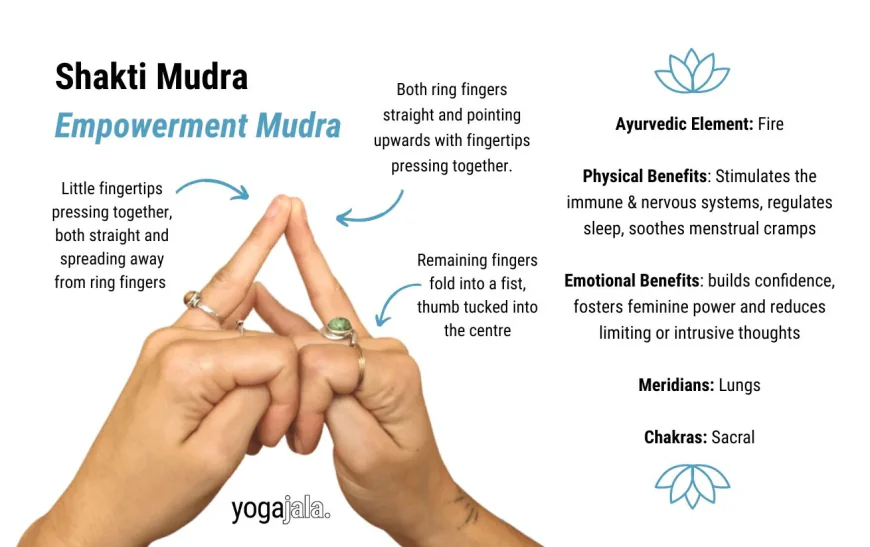
Advanced Mudras
Advanced mudras require greater focus and practice as they involve intricate movements or full-body engagement to direct prana more effectively.
-
Kali Mudra:
Kali Mudra is associated with transformation and strength, invoking the fierce yet protective qualities of Goddess Kali.-
How to Practice: Interlace all fingers except the index fingers, which remain extended and pressed together. Point this gesture upward during meditation or asana practice.
-
Benefits:
-
Invokes inner strength during challenging situations or transitions in life.
-
Clears energetic blockages by stimulating higher chakras like Ajna (third eye) and Sahasrara (crown).
-
-

-
Garuda Mudra:
Garuda Mudra is named after Garuda, the mythical eagle in Hindu mythology known for its immense power and agility. This mudra balances the air element in the body while enhancing intuition.-
How to Practice: Cross your hands at the wrists with palms facing upward. Interlock your thumbs while spreading your fingers outward like wings. Place this gesture near your chest or solar plexus region during practice.
-
Benefits:
-
Balances vata dosha by harmonizing air energy within the body.
-
Enhances intuition by stimulating Ajna Chakra (third eye).
-
-

-
Varada Mudra:
Varada Mudra is a gesture of granting blessings or wishes. It is often used to cultivate compassion and generosity.-
How to Practice: Extend your right hand with the palm facing outward. Keep your fingers together and your wrist straight.
-
Benefits:
-
Cultivates feelings of compassion and generosity.
-
Enhances positive energy flow, promoting well-being and peace.
-
-
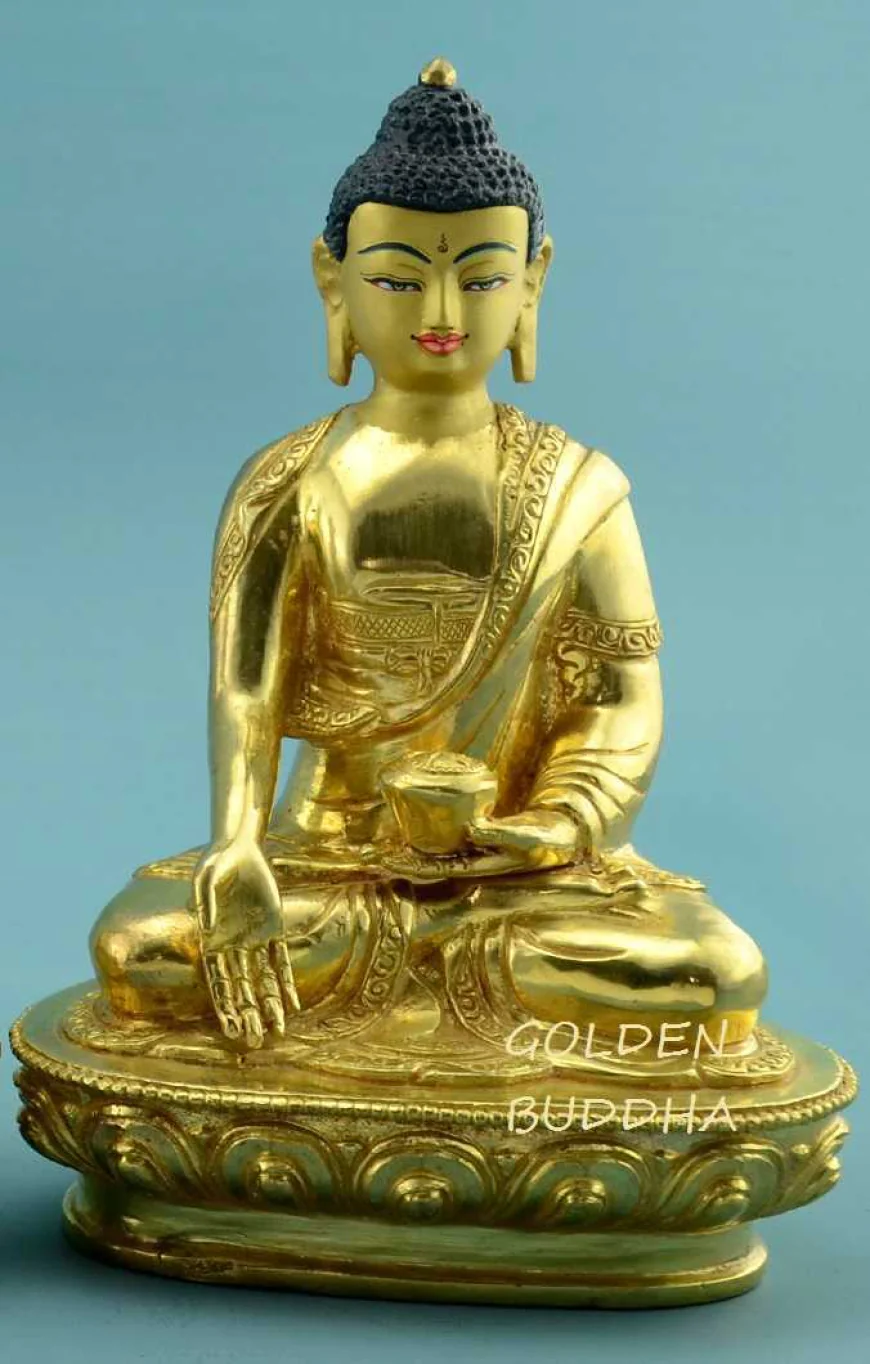
Bandhas for Energy Channeling
Bandhas are internal locks that regulate pranic flow by contracting specific muscle groups in the body. They are often practiced during pranayama or meditation to amplify energetic effects.
-
Mula Bandha (Root Lock):
Mula Bandha is performed by contracting the muscles of the pelvic floor, particularly those around the perineum area. This lock activates root energy at Muladhara Chakra (root chakra) and stabilizes pranic flow upward through Sushumna Nadi (central energy channel).-
How to Practice: Sit comfortably with an erect spine. Inhale deeply and contract the pelvic floor muscles as if stopping urination midstream. Hold this contraction while retaining your breath momentarily before releasing it during exhalation.
-
Benefits:
-
Activates dormant kundalini energy at Muladhara Chakra.
-
Strengthens pelvic floor muscles, improving urogenital health and stability during meditation.
-
-
-
Uddiyana Bandha (Abdominal Lock):
Uddiyana Bandha involves pulling the abdominal muscles inward and upward toward the spine after exhalation, creating a vacuum effect in the thoracic cavity. This lock stimulates Manipura Chakra (solar plexus) while drawing prana upward through Sushumna Nadi.-
How to Practice: Exhale deeply to empty your lungs completely. Hold your breath out while contracting your abdominal muscles inward toward your spine and lifting them upward into your rib cage. Release this lock before inhaling again.
-
Benefits:
-
Stimulates digestive fire (jatharagni), improving metabolism and detoxification processes.
-
Strengthens core muscles while toning abdominal organs like pancreas and liver.
-
-
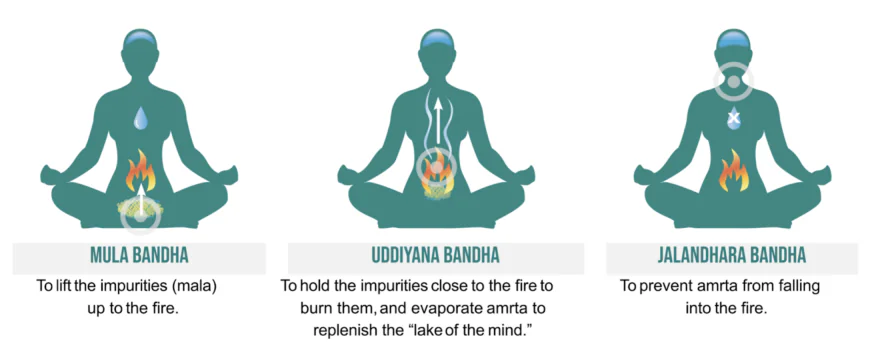
-
Jalandhara Bandha (Throat Lock):
Jalandhara Bandha involves contracting the muscles of the throat to direct prana toward higher chakras. It is often practiced during pranayama to enhance respiratory efficiency and balance thyroid function.-
How to Practice: Sit comfortably with an erect spine. Inhale deeply and then contract your throat muscles by lowering your chin toward your chest. Hold this lock while retaining your breath momentarily before releasing it during exhalation.
-
Benefits:
-
Directs prana toward higher chakras like Ajna (third eye) and Sahasrara (crown).
-
Balances thyroid function, improving metabolism and energy levels.
-
-
Combining Mudras and Bandhas
The combined use of mudras and bandhas amplifies their individual effects by locking pranic energy within specific regions of the body while directing it toward higher chakras for spiritual awakening.
-
During Nadi Shodhana Pranayama (alternate nostril breathing), practitioners can engage Mula Bandha to stabilize root energy while using Nasagra Mudra (hand gesture for alternate nostril control) to regulate breath flow.
-
In advanced practices like Maha Bandha (the great lock), all three primary bandhas—Mula Bandha, Uddiyana Bandha, and Jalandhara Bandha—are engaged simultaneously along with meditation mudras like Jnana Mudra (gesture of wisdom). This combination creates an intense energetic seal that awakens kundalini energy.
Mudras for Emotional Healing
Mudras can be used therapeutically to release emotional blockages and promote emotional balance.
-
Gyan Mudra:
Gyan Mudra, also known as the gesture of wisdom, involves touching the tip of the thumb with the tip of the index finger while extending the other fingers.-
Benefits: Enhances memory, concentration, and mental clarity while calming emotional turmoil.
-
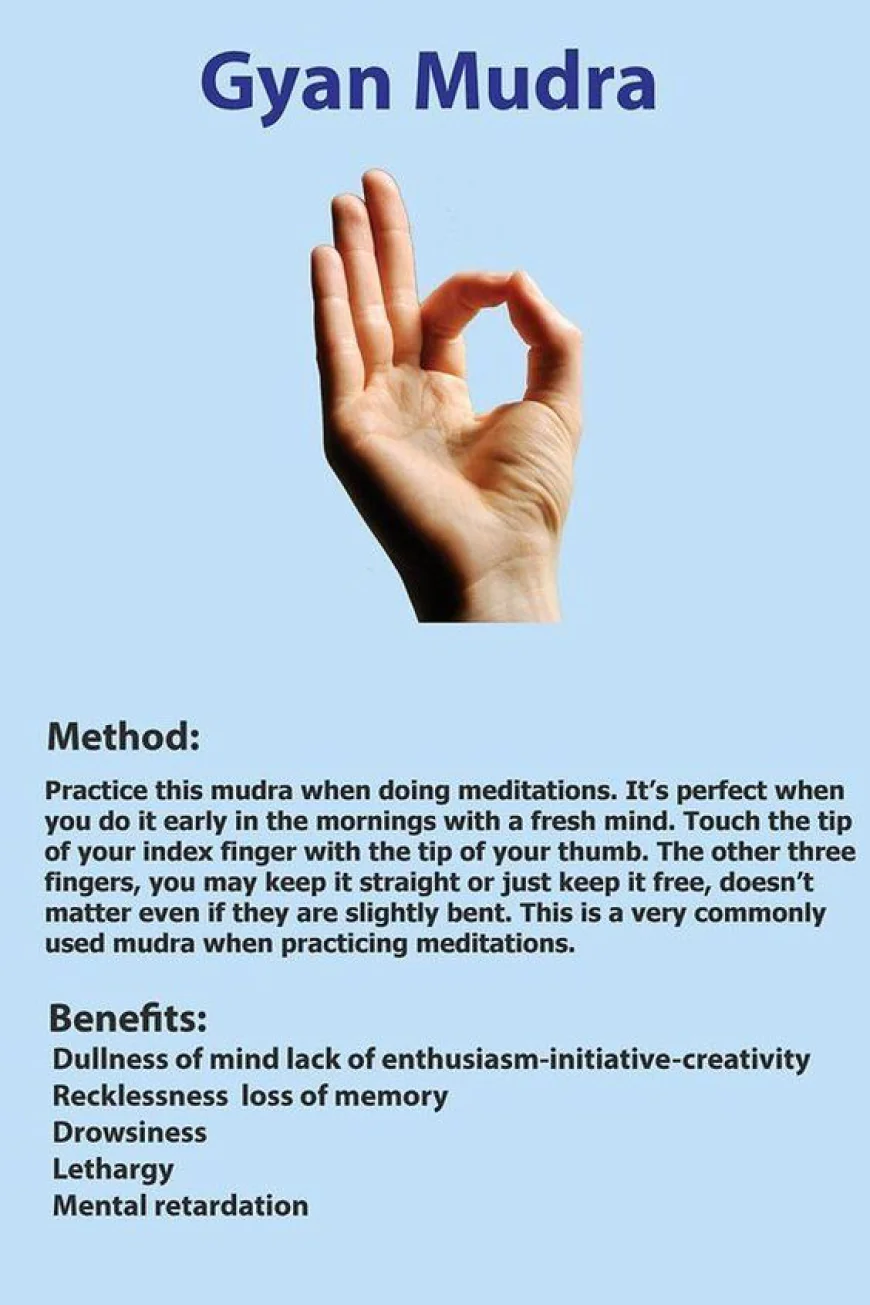
-
Varun Mudra:
Varun Mudra is associated with water element balance. It involves touching the tip of the little finger with the tip of the thumb while extending the other fingers.-
Benefits: Balances emotions by calming the nervous system and promoting relaxation.
-

Bandhas for Physical Strength
Bandhas not only enhance spiritual practices but also contribute to physical strength and stability.
-
Uddiyana Bandha strengthens core muscles, improving posture and reducing back pain.
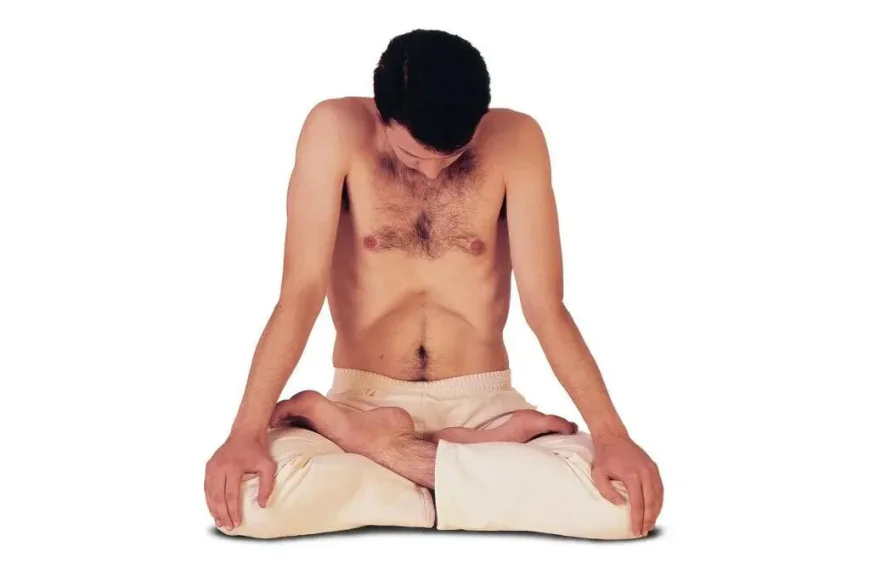
-
Mula Bandha enhances pelvic floor strength, supporting urogenital health and stability during physical activities.

Mudras for Spiritual Growth
Mudras can facilitate spiritual growth by connecting practitioners with higher states of consciousness.
-
Adi Mudra:
Adi Mudra involves curling the fingers into the palm and extending the thumb. It is believed to awaken dormant spiritual potential by stimulating the root chakra.-
Benefits: Enhances spiritual awareness and connects practitioners with their inner selves.
-

-
Prana Mudra:
Prana Mudra involves touching the tips of the ring and little fingers with the tip of the thumb while extending the other fingers. It is said to enhance vitality and pranic flow.-
Benefits: Balances prana, promoting overall well-being and energy levels.
-
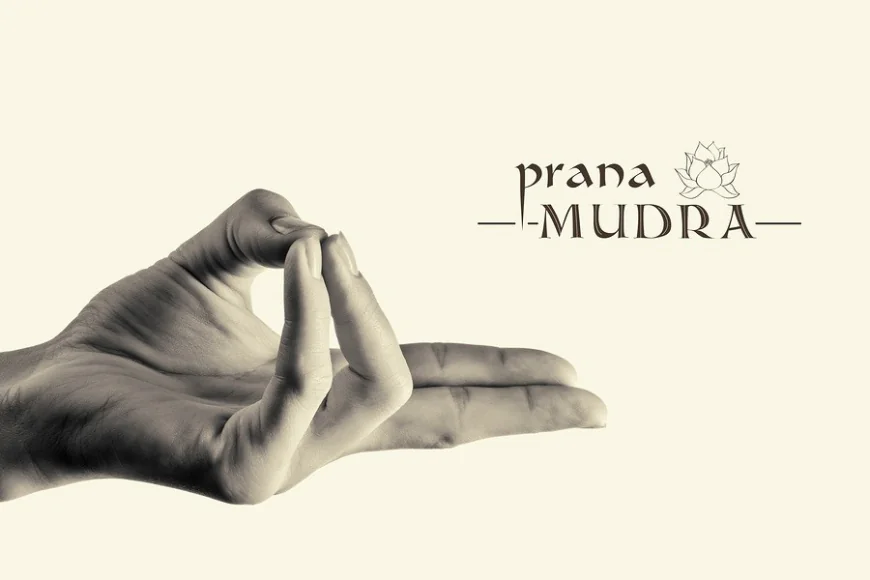
By integrating these practices into daily life, practitioners can experience profound transformations in physical vitality, emotional stability, mental clarity, and spiritual growth. Mudras and bandhas serve as powerful tools for unlocking human potential and achieving a harmonious balance between body, mind, and spirit.
4. Meditation and Visualization
Meditation and visualization are powerful tools that allow individuals to connect deeply with their inner selves, balance their energy systems, and cultivate emotional, mental, and spiritual well-being. Visualization, in particular, is a potent technique that uses the mind’s ability to create mental images to influence energy flow, heal blockages, and enhance mindfulness. When combined with meditation, visualization can harmonize the chakras, awaken dormant energies, and foster a profound sense of inner peace. In this article, we explore various techniques such as chakra visualization, guided imagery practices, mantra-based meditation, and visualization for healing.
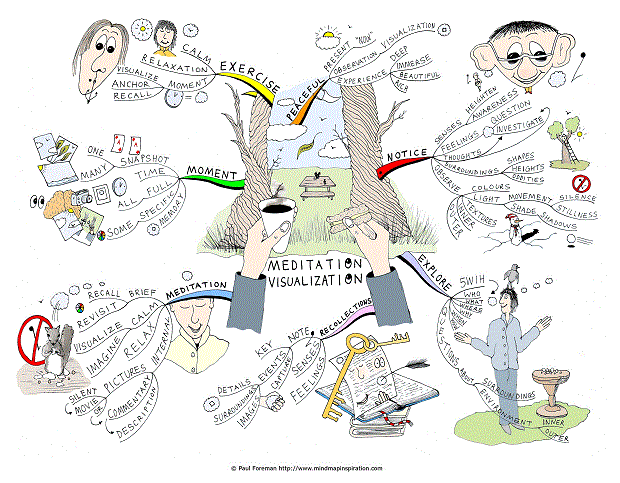
Chakra Visualization Techniques
The chakra system is a network of energy centers located along the spine, each associated with specific physical, emotional, and spiritual functions. Chakra visualization involves focusing on these centers as spinning wheels of light, each vibrating with its unique color and frequency. This technique balances energy flow across the body and aligns the chakras for optimal well-being.
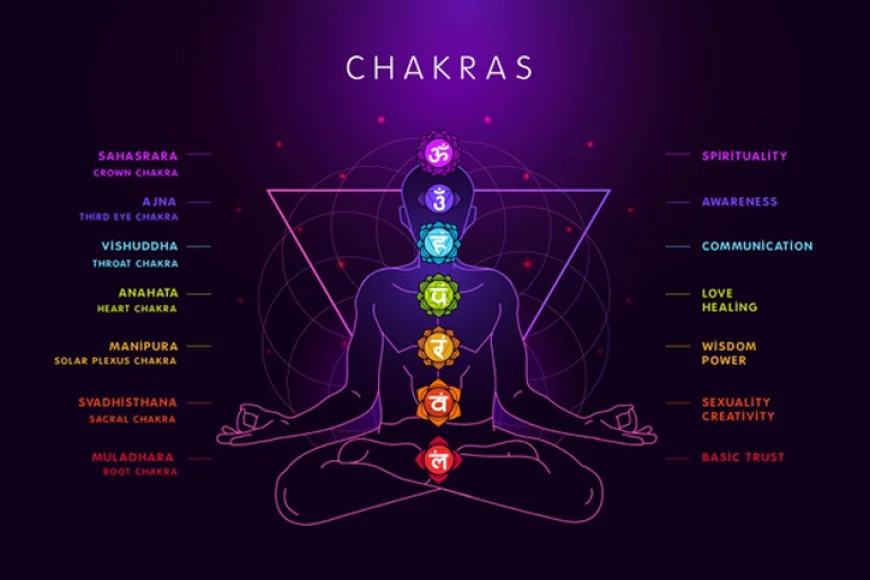
-
Understanding the Chakras:
The human body has seven primary chakras:-
Root Chakra (Muladhara): Located at the base of the spine; associated with stability and grounding. Its color is red.
-
Sacral Chakra (Svadhisthana): Located below the navel; governs creativity and emotions. Its color is orange.
-
Solar Plexus Chakra (Manipura): Located below the ribs; linked to confidence and personal power. Its color is yellow.
-
Heart Chakra (Anahata): Located at the center of the chest; represents love and compassion. Its color is green.
-
Throat Chakra (Vishuddha): Located at the throat; associated with communication and self-expression. Its color is blue.
-
Third Eye Chakra (Ajna): Located between the eyebrows; represents intuition and insight. Its color is indigo.
-
Crown Chakra (Sahasrara): Located at the top of the head; symbolizes spiritual connection and enlightenment. Its color is violet or white.
-
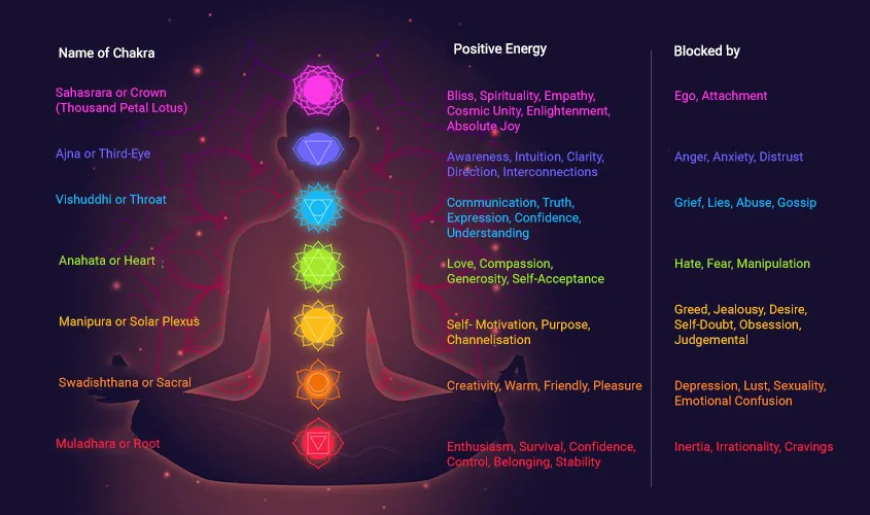
-
Step-by-Step Chakra Visualization:
-
Sit comfortably or lie down in a relaxed position with your spine straight. Close your eyes and take deep breaths to calm your mind.
-
Begin by focusing on your Root Chakra at the base of your spine. Visualize a glowing red ball of light spinning slowly in this area. With each breath, imagine this light becoming brighter and more vibrant as it grounds you to the earth’s energy field.
-
Move your attention upward to your Sacral Chakra below your navel. Visualize an orange sphere of light rotating gently in this region, awakening creativity and emotional balance.
-
Shift your focus to your Solar Plexus Chakra below your ribs. Imagine a yellow ball of light spinning here, radiating confidence and inner strength throughout your body.
-
Bring your awareness to your Heart Chakra at the center of your chest. Visualize a green sphere of light spinning harmoniously, filling you with love, compassion, and emotional stability.
-
Focus on your Throat Chakra at the center of your throat. Envision a blue ball of light rotating here, enhancing clarity in communication and self-expression.
-
Direct your attention to your Third Eye Chakra between your eyebrows. Visualize an indigo sphere spinning gently in this area, sharpening intuition and insight into life’s mysteries.
-
Finally, bring your focus to your Crown Chakra at the top of your head. Imagine a violet or white lotus flower blooming upward toward infinite space, connecting you to universal consciousness.
-
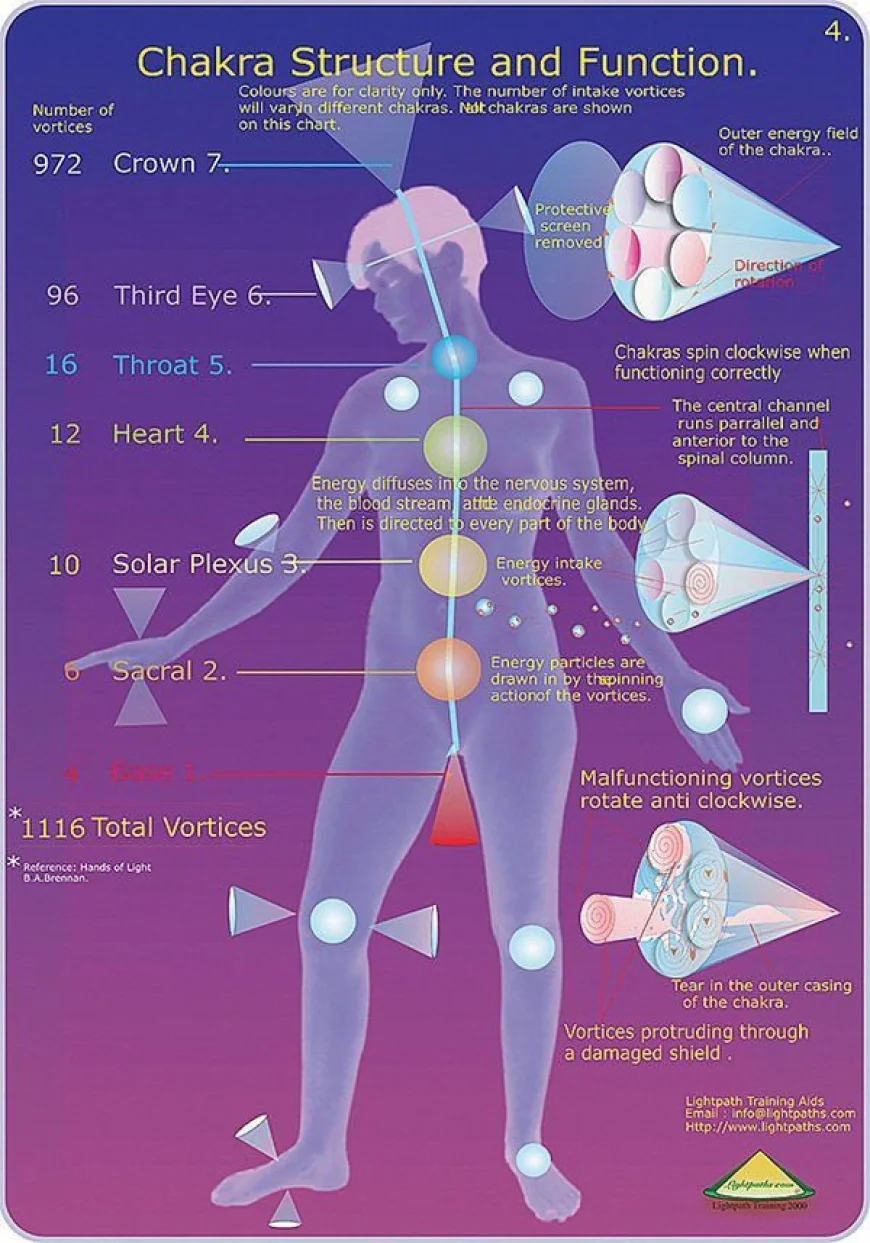
-
Connecting All Chakras:
After visualizing each chakra individually, imagine a bright white ray of light rising from the earth through your Root Chakra and passing through all other chakras in sequence until it reaches the Crown Chakra at the top of your head. This alignment stabilizes energy flow throughout your body.
Guided Imagery Practices
Guided imagery uses mental visualization to create positive images that influence emotions, thoughts, or physical sensations.
-
Meeting Your Inner Goddess:
This practice involves visualizing divine feminine archetypes such as Durga or Saraswati to connect with Shakti energy (feminine power).-
Begin by sitting comfortably in meditation posture with closed eyes.
-
Visualize yourself in a serene natural setting—a lush garden or a peaceful mountaintop.
-
Imagine Durga riding her lion or Saraswati seated on her lotus flower approaching you.
-
Engage in an imaginary dialogue where you ask for guidance or blessings.
-
Feel their divine presence empowering you with courage (Durga) or wisdom (Saraswati).
-

-
Peaceful Place Visualization:
This technique involves imagining yourself in a tranquil location such as a beach or forest to reduce stress and anxiety.-
Picture every detail vividly—the sound of waves crashing onshore or birds chirping in trees.
-
Allow this imagery to evoke feelings of safety while grounding yourself emotionally.
-

-
Inner Child Healing:
Visualize yourself as a child in a nurturing environment, surrounded by love and support. This practice helps heal emotional wounds from childhood and fosters self-compassion.
Mantra-Based Meditation
Mantras are sacred sounds or phrases that carry vibrational frequencies capable of influencing consciousness when repeated during meditation.
-
Chanting "Om Shakti Om": This mantra invokes Shakti's presence within you while harmonizing vibrations across all chakras.
-
Chanting "Om Aim Hreem Kleem": These bija mantras (seed sounds) represent Saraswati (Aim), Lakshmi (Hreem), and Kali (Kleem), invoking wisdom, abundance, and transformation respectively.
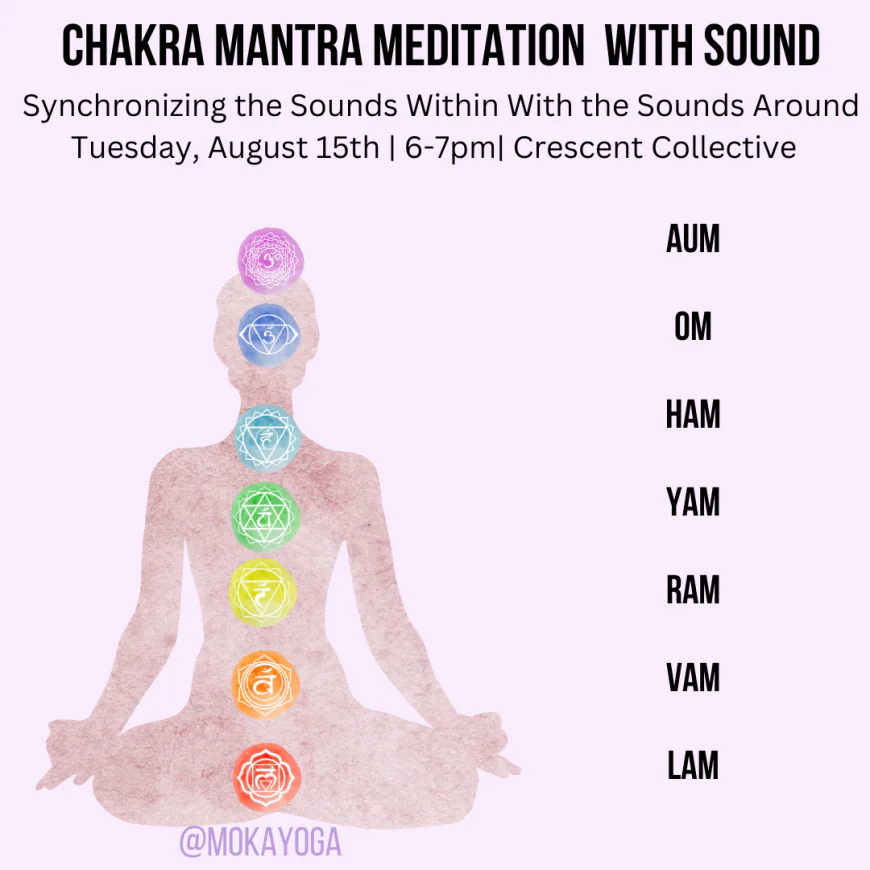
Visualization for Healing
Visualization can also be used as a therapeutic tool for healing physical ailments or emotional wounds by directing positive energy toward affected areas.
-
Golden Light Healing Visualization:
-
Sit comfortably with closed eyes.
-
Imagine a warm golden light descending from above into your Crown Chakra.
-
Visualize this light flowing through each chakra sequentially while dissolving blockages along its path.
-
Picture it spreading throughout every cell in your body like sunlight illuminating darkness—healing pain or discomfort wherever it touches.
-
-
Inner Light Visualization: Focus on visualizing an inner light radiating from within your heart center outward toward others around you—transforming negative emotions into compassion-filled vibrations.
Benefits of Meditation & Visualization
-
Balances emotional states by reducing stress hormones like cortisol.
-
Enhances focus & creativity through improved neural connectivity between hemispheres.
-
Promotes spiritual awakening by aligning subtle energies within chakras.
Advanced Visualization Techniques
-
Visualization for Manifestation:
Imagine yourself already in possession of what you desire—whether it’s a successful career, a loving relationship, or improved health. Visualize every detail vividly, including how you feel and the sensations associated with achieving your goal. -
Visualization for Protection:
Envision a protective shield of light surrounding your body, deflecting negative energies and maintaining a safe, peaceful space around you. -
Visualization for Gratitude:
Visualize yourself in situations where you feel grateful—such as being surrounded by loved ones or experiencing nature’s beauty. Focus on the emotions of gratitude to cultivate a positive mindset.
Combining Meditation with Yoga and Pranayama
Integrating meditation with yoga and pranayama enhances the benefits of each practice. Yoga postures prepare the body for meditation by aligning the chakras and improving flexibility. Pranayama techniques, such as alternate-nostril breathing, further balance the nervous system and prepare the mind for deeper states of consciousness.
Mindfulness and Awareness
Mindfulness is the practice of being fully present and aware of the current moment. It complements meditation by fostering a deeper connection with one’s thoughts, emotions, and physical sensations.
-
Mindfulness Meditation: Focus on your breath or body sensations without judgment, cultivating awareness and reducing mental chatter.
-
Walking Meditation: Pay attention to each step while walking slowly, integrating mindfulness into daily activities.
Emotional Healing through Meditation
Meditation can be a powerful tool for emotional healing by allowing individuals to confront and release suppressed emotions.
-
Emotional Release Techniques: Use visualization or guided imagery to imagine releasing emotional blockages, such as picturing tears flowing or letting go of burdens.
-
Self-Compassion Practices: Cultivate self-love and acceptance through affirmations or loving-kindness meditation.
Spiritual Growth through Meditation
Meditation facilitates spiritual growth by connecting practitioners with higher states of consciousness and universal energy.
-
Chakra Activation: Focus on each chakra to awaken dormant energies and enhance spiritual awareness.
-
Visualization of Cosmic Connection: Imagine yourself connected to the universe, fostering a sense of unity and oneness with all existence.
By integrating these practices into daily life routines—whether through guided imagery scripts tailored toward specific goals like meeting inner goddesses—or chakra balancing meditations designed explicitly around color-coded systems—individuals unlock profound transformative potential lying dormant inside themselves! Meditation and visualization serve as bridges between the physical and spiritual realms, offering tools for healing, growth, and enlightenment.
5. Yoga Nidra and Deep Relaxation
Yoga Nidra, often referred to as "yogic sleep," is a profound practice that combines guided meditation with deep relaxation techniques. It is designed to bring the body into a state of complete relaxation while maintaining a level of consciousness, allowing practitioners to access deeper states of awareness and healing. This practice is accessible to everyone, regardless of age or physical ability, as it requires no movement and can be performed lying down. Below, we explore the steps of Yoga Nidra, its benefits, and how it contributes to deep relaxation and overall well-being.

Steps of Yoga Nidra
Yoga Nidra involves a systematic approach to relaxation and inner awareness. Here are the key steps involved in a typical Yoga Nidra session:
-
Initial Relaxation/Settling:
Begin by lying down comfortably in Shavasana (corpse pose) with your back supported if needed. Close your eyes and take deep breaths to calm your mind and body. The goal is to settle into a peaceful state, letting go of any tension or distractions. -
Sankalpa Setting:
Create a positive affirmation or intention (Sankalpa) that you wish to manifest in your life. This could be something like "I am strong and capable" or "I am at peace with myself." Setting a Sankalpa helps focus your mind and brings purpose to your practice. -
Body Rotation:
Systematically bring awareness to each part of your body, starting from your toes and moving up to the crown of your head. As you focus on each area, release any tension or discomfort, allowing your body to relax further. -
Breathing Awareness:
Focus on your breath, observing its natural flow without attempting to control it. This step helps draw your attention inward, away from external distractions. -
Experience of Opposite Sensations:
Imagine experiencing opposite sensations in your body, such as feeling hot and cold simultaneously. This practice helps balance your nervous system and enhances your ability to manage contrasting emotions. -
Visualization:
Engage in guided visualizations, such as imagining yourself in a peaceful environment or visualizing a specific scenario. This step deepens your relaxation and enhances your ability to focus. -
Revisiting Sankalpa:
Reiterate your Sankalpa at the end of the session, allowing it to sink deeply into your subconscious mind. This reinforces your intention and helps manifest positive change in your life. -
Externalization:
Gradually bring your awareness back to your body and the external environment. Take a few deep breaths, noticing how you feel before slowly opening your eyes.
Benefits of Yoga Nidra
Yoga Nidra offers numerous benefits that contribute to overall well-being:
-
Reduces Stress and Anxiety:
By activating the parasympathetic nervous system, Yoga Nidra calms the mind and body, reducing stress hormones like cortisol and promoting relaxation. -
Improves Sleep:
Regular practice can help improve sleep quality by training the body to enter deep relaxation states, making it easier to fall asleep and stay asleep. -
Enhances Memory and Cognition:
Yoga Nidra enhances cognitive function by improving memory and concentration. It does so by creating a state of maximum receptivity in the subconscious mind. -
Promotes Healing:
This practice supports physical and emotional healing by restoring the flow of prana (life energy) and enhancing the body’s natural healing processes. -
Supports Emotional Release:
Yoga Nidra provides a safe space to confront and release suppressed emotions, promoting emotional balance and well-being. -
Boosts Immune System:
By reducing stress and promoting relaxation, Yoga Nidra can help improve immune function, supporting overall health. -
Increases Self-Awareness:
This practice fosters greater self-awareness by allowing practitioners to explore their thoughts, emotions, and intentions in a non-judgmental space.
Deep Relaxation Techniques
Deep relaxation is a state where the body and mind are completely at rest, yet the consciousness remains alert. Yoga Nidra is a powerful tool for achieving this state, but other techniques can also be used:
-
Progressive Muscle Relaxation:
This involves systematically tensing and relaxing different muscle groups in the body to release physical tension. -
Mindfulness Meditation:
Focus on the present moment, often through breath awareness or body scan, to calm the mind and reduce stress. -
Visualization for Relaxation:
Imagine yourself in a peaceful environment or scenario to evoke feelings of calmness and tranquility.
Combining Yoga Nidra with Other Practices
Yoga Nidra can be combined with other yogic practices to enhance its benefits:
-
Yoga Asanas: Practicing gentle stretches or restorative yoga before Yoga Nidra can prepare the body for deeper relaxation.
-
Pranayama: Techniques like alternate-nostril breathing or bellows breath can be used before Yoga Nidra to balance the nervous system and enhance relaxation.
-
Meditation: Following Yoga Nidra with a seated meditation practice can deepen introspection and enhance spiritual growth.
Advanced Yoga Nidra Techniques
For those who have mastered the basic steps, advanced techniques can further deepen the practice:
-
Visualization of Chakras: Visualize each chakra as a spinning wheel of light, enhancing energy flow and balance.
-
Guided Imagery for Emotional Healing: Use visualization to confront and release emotional blockages in a safe and controlled environment.
-
Sankalpa for Manifestation: Use your Sankalpa to focus on specific life goals or transformations, reinforcing positive change.
Benefits for Mental Health
Yoga Nidra has been shown to have positive effects on mental health by reducing symptoms of anxiety and depression. It provides a safe space for emotional release and healing, promoting emotional resilience and well-being.
Physiological Effects
Research has demonstrated that Yoga Nidra can lead to positive physiological changes, including improvements in blood glucose levels, hormonal balance, and immune function. It also enhances cognitive performance by improving memory and concentration.
Yoga Nidra for Emotional Healing
Yoga Nidra offers a unique opportunity for emotional healing by allowing practitioners to confront and release suppressed emotions in a safe environment.
-
Emotional Release Techniques: Use visualization or guided imagery to imagine releasing emotional blockages, such as picturing tears flowing or letting go of burdens.
-
Self-Compassion Practices: Cultivate self-love and acceptance through affirmations or loving-kindness meditation.
Yoga Nidra for Spiritual Growth
This practice facilitates spiritual growth by connecting practitioners with higher states of consciousness and universal energy.
-
Chakra Activation: Focus on each chakra to awaken dormant energies and enhance spiritual awareness.
-
Visualization of Cosmic Connection: Imagine yourself connected to the universe, fostering a sense of unity and oneness with all existence.
Yoga Nidra for Better Sleep
Regular practice can significantly improve sleep quality by training the body to enter deep relaxation states.
-
Pre-Sleep Routine: Incorporate Yoga Nidra into your bedtime routine to prepare your body for restful sleep.
-
Reducing Insomnia: Helps manage insomnia by calming the nervous system and promoting relaxation.
Yoga Nidra for Stress Management
Yoga Nidra is an effective tool for managing stress by reducing cortisol levels and promoting relaxation.
-
Workplace Stress Relief: Practice Yoga Nidra during breaks to reduce stress and improve productivity.
-
Daily Stress Reduction: Incorporate Yoga Nidra into your daily routine to maintain emotional balance.
Yoga Nidra for Physical Health
This practice supports physical health by enhancing immune function and promoting healing.
-
Pain Management: Use Yoga Nidra to manage chronic pain by reducing inflammation and promoting relaxation.
-
Immune System Boost: Regular practice can help improve immune function by reducing stress and enhancing overall well-being.
By integrating Yoga Nidra into daily life, individuals can experience profound benefits that extend beyond relaxation to include improved mental clarity, emotional balance, and overall well-being. This practice serves as a powerful tool for managing stress, enhancing sleep quality, and fostering a deeper connection with one’s inner self.
6. Rituals and Ceremonies
Rituals and ceremonies have been integral to human culture for centuries, serving as a means to connect with the divine, honor nature’s cycles, and foster inner transformation. In the context of Shakti energy, rituals and ceremonies are deeply rooted in spiritual practices that awaken, channel, and celebrate the divine feminine energy within us. Shakti represents the primordial cosmic energy responsible for creation, preservation, and transformation. Through daily rituals and seasonal ceremonies, individuals can align with this powerful energy to cultivate balance, creativity, and spiritual growth. Below, we explore daily rituals for Shakti energy, seasonal ceremonies like equinoxes and solstices, and their significance in awakening the divine feminine.
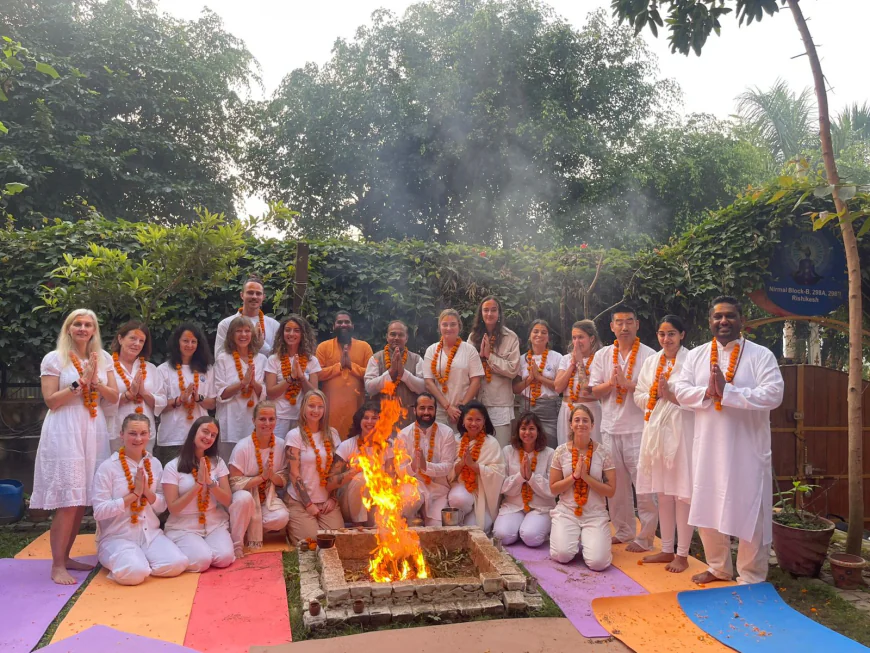
Daily Rituals for Shakti Energy
Daily rituals are simple yet powerful practices that help individuals maintain a consistent connection with their inner Shakti energy. These rituals are designed to integrate mindfulness, gratitude, and self-awareness into everyday life.
-
Morning Gratitude Practice:
Starting the day with gratitude is one of the most effective ways to align with Shakti energy. Gratitude opens the heart chakra (Anahata) and fosters a sense of abundance and positivity.-
How to Practice:
-
Upon waking up, sit quietly in a comfortable position.
-
Close your eyes and take deep breaths to center yourself.
-
Reflect on three things you are grateful for—these could be as simple as the warmth of the sun or the presence of loved ones.
-
Repeat affirmations such as “I am grateful for the energy that flows through me” or “I honor the divine feminine within.”
-
-
Benefits:
-
Cultivates a positive mindset and emotional resilience.
-
Enhances mindfulness by focusing on the present moment.
-
-
-
Affirmation Rituals:
Affirmations are powerful statements that program the subconscious mind to align with your intentions. Incorporating affirmations into your morning routine can help activate Shakti energy.-
Examples of Affirmations:
-
“I am creative and powerful.”
-
“I embrace my inner goddess.”
-
“I am connected to the cycles of nature.”
-
-
Advanced Affirmations:
-
“I trust my intuition and inner wisdom.”
-
“I am worthy of love and respect.”
-
“I embody strength and resilience.”
-
-
-
Sacral Chakra Activation:
The sacral chakra (Svadhisthana) is closely associated with Shakti energy as it governs creativity, emotions, and sensuality. Activating this chakra through specific rituals can enhance your connection with Shakti.-
Practices:
-
Perform hip-opening yoga poses such as Goddess Pose (Utkata Konasana) or Butterfly Pose (Baddha Konasana).
-
Meditate using the mantra “VAM,” which is the seed sound of the sacral chakra.
-
Engage in creative activities like painting or dancing to express your emotions and creativity.
-
-
-
Journaling:
Journaling is a reflective practice that allows you to explore your emotions and connect with your inner self. Writing about your thoughts, feelings, or dreams can help activate Shakti energy by fostering self-awareness.-
How to Practice: Dedicate 10–15 minutes each morning or evening to freewriting about your emotions or intentions for the day.
-
Advanced Journaling Techniques:
-
Write letters to your inner goddess, expressing gratitude or seeking guidance.
-
Reflect on your dreams, exploring their symbolism and connection to your subconscious mind.
-
-
-
Shakti Mudra Practice:
The Shakti Mudra is a hand gesture that activates feminine energy by stimulating the sacral chakra. Practicing this mudra during meditation enhances creativity and emotional balance.-
How to Practice: Sit comfortably with your hands resting on your thighs. Curl your index fingers inward toward your palms while touching the tips of your ring fingers and pinky fingers together.
-
Benefits:
-
Enhances creativity and emotional awareness.
-
Balances the sacral chakra, promoting emotional stability.
-
-
Seasonal Rituals
Seasonal rituals honor nature’s cycles, such as equinoxes and solstices, which represent moments of balance or transition in the natural world. These ceremonies provide an opportunity to realign with Shakti energy by celebrating life’s rhythms.
-
Spring Equinox Ceremony:
The spring equinox marks a time of renewal and growth when day and night are equal in length. It symbolizes balance and new beginnings—an ideal time to awaken dormant Shakti energy.-
Practices:
-
Perform a cleansing ritual by lighting incense or sage to purify your space.
-
Engage in creative activities such as painting or gardening to honor the creative aspect of Shakti.
-
Meditate on themes of growth and renewal while visualizing seeds sprouting into vibrant life.
-
-
Significance: This ceremony aligns with Shakti’s nurturing qualities, fostering creativity and new opportunities.
-
-
Summer Solstice Celebration:
The summer solstice is the longest day of the year, symbolizing light, abundance, and vitality.-
Practices:
-
Practice Sun Salutations (Surya Namaskar) at sunrise to honor solar energy.
-
Create an altar with symbols of abundance such as flowers, fruits, or candles.
-
Chant mantras like “Om Shakti Om” to invoke divine feminine power.
-
-
Significance: This celebration embodies Shakti’s dynamic aspect as a source of vitality and empowerment.
-
-
Autumn Equinox Ceremony:
The autumn equinox represents balance between light and darkness as nature transitions toward rest.-
Practices:
-
Reflect on what you’ve harvested in terms of personal growth or achievements over the past year.
-
Perform grounding yoga poses such as Mountain Pose (Tadasana) or Tree Pose (Vrikshasana).
-
Express gratitude through journaling or creating a gratitude jar.
-
-
Significance: This ceremony honors Shakti’s transformative power as she guides us through cycles of change.
-
-
Winter Solstice Rituals:
The winter solstice marks the longest night of the year—a time for introspection and renewal.-
Practices:
-
Light candles or lanterns to symbolize hope and light returning after darkness.
-
Meditate on themes of inner strength while visualizing Shakti as a guiding force through challenges.
-
Engage in restorative yoga practices like Child’s Pose (Balasana) or Corpse Pose (Savasana).
-
-
Significance: This ritual celebrates Shakti’s quiet strength during periods of stillness.
-
The Role of Festivals in Honoring Shakti
In Hinduism, festivals such as Navaratri are dedicated to worshiping different forms of Goddess Shakti (Durga, Kali, Saraswati). These festivals provide structured opportunities for spiritual growth through fasting, meditation, chanting mantras like “Om Aim Hreem Kleem,” and performing sacred rituals.
-
Navaratri Practices:
During Navaratri (nine nights dedicated to Devi), devotees perform daily pujas (worship), chant hymns like Durga Saptashati, observe fasting rituals aligned with purification practices, meditate on goddess archetypes representing courage (Durga), wisdom (Saraswati), or abundance (Lakshmi).
Creating Personal Ceremonies
You don’t need formal settings to honor Shakti; personal ceremonies can be just as meaningful:
-
Create an altar at home featuring symbols representing feminine strength—such as flowers (creativity), water (intuition), candles (transformation).
-
Incorporate elements like crystals associated with sacral chakra activation—such as carnelian—for enhanced connection during meditative states.
Moon Cycle Rituals
Moon cycles offer another opportunity to connect with Shakti energy by honoring the feminine cycles of nature.
-
New Moon Rituals:
-
Practices: Set intentions for new beginnings, write down goals, and perform a cleansing ritual to prepare for growth.
-
Significance: Aligns with Shakti’s creative potential, fostering new opportunities.
-
-
Full Moon Rituals:
-
Practices: Reflect on accomplishments, release what no longer serves you, and celebrate your achievements.
-
Significance: Honors Shakti’s transformative power, promoting release and renewal.
-
Rituals for Life Transitions
Rituals can also be created to mark significant life transitions, such as birth, marriage, or menopause, to honor these milestones and invoke Shakti’s guidance.
-
Birth Rituals: Celebrate new life with ceremonies that honor the mother and child, invoking Shakti’s nurturing qualities.
-
Menopause Rituals: Mark this transition with rituals that honor wisdom and transformation, celebrating the woman’s journey into a new phase of life.
Benefits of Rituals and Ceremonies
-
Emotional Healing: Rituals provide a safe space for emotional release and healing.
-
Spiritual Growth: Ceremonies connect practitioners with higher states of consciousness and universal energy.
-
Community Building: Participating in group rituals fosters a sense of community and shared spiritual practice.
Advanced Ritual Practices
For those who have mastered basic rituals, advanced practices can further deepen the connection with Shakti energy:
-
Tantric Rituals: Explore practices that honor the divine union of opposites (Shiva and Shakti), such as tantric yoga or meditation with a partner.
-
Sacred Dance: Use dance as a form of ritual expression to embody Shakti’s dynamic energy.
Rituals for Emotional Balance
Rituals can be tailored to promote emotional balance by focusing on specific themes or intentions.
-
Forgiveness Rituals: Create a ceremony to release past hurts and foster forgiveness, using practices like writing letters or burning them symbolically.
-
Self-Love Rituals: Perform rituals that honor self-love and self-acceptance, such as mirror work or affirmations.
By integrating daily rituals alongside seasonal celebrations honoring natural cycles—individuals unlock profound transformative potential aligning themselves harmoniously within universal rhythms governed by Divine Feminine principles encapsulated within "ShAKTI." These practices serve as bridges between the physical and spiritual realms, offering tools for healing, growth, and enlightenment.
7. Diet and Nutrition for Chakra Balancing
Diet plays a significant role in maintaining the balance of the chakras, which are the seven primary energy centers in the body. Each chakra corresponds to specific physical, emotional, and spiritual functions and is associated with a particular color and element. By consuming foods that align with the vibrational frequency of each chakra, we can promote balance, vitality, and overall well-being. Additionally, incorporating herbal adaptogens like ashwagandha and shatavari can support hormonal balance and enhance Shakti energy. This article explores foods for each chakra, herbal support for Shakti energy, and how nutrition can be used as a tool for holistic health.

Foods for Each Chakra
The chakras are aligned along the spine, starting from the Root Chakra at the base to the Crown Chakra at the top of the head. Each chakra has unique dietary needs based on its color and energetic properties.
1. Root Chakra (Muladhara)
The Root Chakra is located at the base of the spine and is associated with grounding, stability, and survival instincts. Its color is red, and its element is earth.
-
Foods to Balance Root Chakra:
-
Root vegetables: Carrots, beets, sweet potatoes, radishes, parsnips, onions, garlic.
-
Protein-rich foods: Eggs, beans, tofu, lentils, peanut butter.
-
Red fruits: Pomegranates, strawberries, raspberries.
-
Spices: Paprika, cayenne pepper, horseradish.
-
-
Why These Foods Work:
Root vegetables grow beneath the ground and are rich in nutrients like folate and beta-carotene that help stabilize energy. Protein provides strength and sustenance to meet survival needs. -
Sample Meal: Roasted beet salad with garlic dressing and a side of lentil soup.
2. Sacral Chakra (Svadhisthana)
The Sacral Chakra is located below the navel and governs creativity, emotions, and sensuality. Its color is orange, and its element is water.
-
Foods to Balance Sacral Chakra:
-
Orange fruits: Mangoes, oranges, peaches, apricots.
-
Nuts and seeds: Almonds, walnuts, flaxseeds.
-
Omega-3 rich foods: Salmon or chia seeds.
-
Hydrating foods: Coconut water or herbal teas like chamomile.
-
-
Why These Foods Work:
Orange-colored foods resonate with this chakra’s vibrational frequency while hydrating foods align with its water element. -
Sample Meal: Grilled salmon with a side of roasted sweet potatoes and a glass of fresh orange juice.
3. Solar Plexus Chakra (Manipura)
The Solar Plexus Chakra is located above the navel and governs personal power, confidence, and digestion. Its color is yellow, and its element is fire.
-
Foods to Balance Solar Plexus Chakra:
-
Yellow fruits: Bananas, pineapples, lemons.
-
Whole grains: Brown rice, oats, quinoa.
-
Spices: Turmeric, ginger, cumin.
-
-
Why These Foods Work:
Yellow foods enhance mood and energy levels while whole grains provide sustainable energy to fuel willpower. -
Sample Meal: Quinoa salad with roasted yellow peppers and a turmeric-ginger dressing.
4. Heart Chakra (Anahata)
The Heart Chakra is located at the center of the chest and represents love, compassion, and emotional healing. Its colors are green and pink; its element is air.
-
Foods to Balance Heart Chakra:
-
Leafy greens: Spinach, kale, chard.
-
Green fruits: Avocadoes, kiwi, green apples.
-
Herbal teas: Green tea or matcha tea infused with mint or basil.
-
-
Why These Foods Work:
Green foods are rich in antioxidants that promote cardiovascular health while aligning with this chakra’s vibrational frequency. -
Sample Meal: Kale salad with avocado slices topped with lime juice and a cup of green tea.
5. Throat Chakra (Vishuddha)
The Throat Chakra governs communication and self-expression. Its color is blue or turquoise; its element is ether.
-
Foods to Balance Throat Chakra:
-
Liquids: Water infused with lemon or herbal teas like chamomile or peppermint tea.
-
Blue fruits: Blueberries or blackberries.
-
Cooling foods: Coconut milk or cucumber slices.
-
-
Why These Foods Work:
Hydration supports vocal clarity while blue foods resonate energetically with this chakra’s frequency. -
Sample Meal: A smoothie made from blueberries blended with coconut water.
6. Third Eye Chakra (Ajna)
The Third Eye Chakra is located between the eyebrows and governs intuition and insight. Its color is indigo; its element is light.
-
Foods to Balance Third Eye Chakra:
-
Indigo-colored fruits: Blackberries or figs.
-
Spices like poppy seeds.
-
Herbal teas like lavender-infused blends for calming effects.
-
-
Why These Foods Work:
Indigo-colored produce enhances cognitive clarity while calming herbs soothe mental overactivity.
7. Crown Chakra (Sahasrara)
The Crown Chakra is located at the top of the head and represents spiritual connection and enlightenment. Its colors are violet or white; its element is thought.
-
Foods to Balance Crown Chakra:
-
Purple fruits: Grapes, plums, purple cabbage.
-
Fasting or detoxifying foods: Herbal teas like peppermint or chamomile for cleansing.
-
Spiritual foods: Foods prepared with love and intention, such as homemade meals.
-
-
Why These Foods Work:
Purple foods resonate with the Crown Chakra’s vibrational frequency while fasting or detoxifying foods help cleanse the body and mind for spiritual clarity. -
Sample Meal: A simple meal of steamed vegetables with a side of purple cabbage salad.
Herbal Support for Shakti Energy
Adaptogens are herbs that help the body adapt to stress and promote balance in the hormonal system. They are particularly beneficial for supporting Shakti energy by enhancing vitality and hormonal balance.
-
Ashwagandha: Known for its ability to reduce stress and anxiety, ashwagandha also supports adrenal function and hormonal balance. It enhances vitality and mental clarity, making it an excellent herb for balancing the Root and Solar Plexus Chakras.
-
Shatavari: This herb is often referred to as the "Queen of Herbs" for women. It supports reproductive health, enhances fertility, and balances hormonal fluctuations. Shatavari is particularly beneficial for the Sacral and Heart Chakras, promoting emotional balance and nurturing qualities.
-
Tulsi (Holy Basil): Known for its calming effects, tulsi supports immune function and mental clarity. It is beneficial for balancing the Throat and Third Eye Chakras by enhancing communication skills and intuition.

Ayurvedic Principles for Chakra Balancing
Ayurveda, the ancient Indian system of medicine, emphasizes the importance of diet in maintaining health and balance. By understanding your dosha (Vata, Pitta, Kapha), you can tailor your diet to support chakra balance.
-
Vata Dosha: Individuals with a dominant Vata dosha benefit from warm, nourishing foods like oats, sweet potatoes, and ginger to ground their energy.
-
Pitta Dosha: Those with a dominant Pitta dosha should consume cooling foods like cucumbers, melons, and mint to balance their fiery nature.
-
Kapha Dosha: Kapha types benefit from light, warming foods like cayenne pepper, turmeric, and whole grains to stimulate digestion and metabolism.

Mindful Eating Practices
Mindful eating is a practice that enhances the connection between food, body, and spirit. It involves eating slowly, savoring each bite, and being fully present during meals.
-
Benefits: Enhances digestion, reduces stress, and fosters gratitude for the food we eat.
-
Practices: Eat in silence, focus on flavors and textures, and express gratitude for the meal.
Fasting and Detoxification
Fasting and detoxification practices can be used to cleanse the body and prepare it for spiritual practices. These practices help align the body with higher states of consciousness.
-
Types of Fasts: Water fasts, juice fasts, or intermittent fasting.
-
Benefits: Enhances spiritual clarity, promotes physical cleansing, and supports mental focus.
Nutrition for Emotional Balance
Certain foods can support emotional balance by influencing neurotransmitter levels and hormonal stability.
-
Omega-3 Rich Foods: Salmon, walnuts, and chia seeds support brain health and mood stability.
-
Complex Carbohydrates: Whole grains like brown rice and quinoa help regulate serotonin levels, promoting emotional calmness.
Nutrition for Physical Strength
A balanced diet is essential for maintaining physical strength and vitality.
-
Protein-Rich Foods: Include lean proteins like chicken, fish, and tofu to support muscle health.
-
Iron-Rich Foods: Consume iron-rich foods like spinach and beans to prevent fatigue and support energy levels.
By integrating these dietary practices into daily life, individuals can experience profound benefits that extend beyond physical health to include emotional balance, mental clarity, and spiritual growth. Nutrition serves as a powerful tool for aligning with Shakti energy, fostering a deeper connection with one’s inner self and the natural world.
Sound Healing: Harnessing Vibrations for Chakra Balancing
Sound healing, an ancient practice rooted in the use of sacred vibrations, has gained immense popularity as a holistic method for balancing the mind, body, and spirit. This practice involves the use of specific frequencies to harmonize the body’s energy centers, known as chakras. Instruments like Tibetan singing bowls, tuning forks, gongs, and crystal bowls are tuned to these frequencies and are used to promote healing, restoration, and spiritual awakening. Below, we explore how sound healing works, the role of chakra-specific frequencies, and the benefits of using instruments such as Tibetan singing bowls in sound therapy.
What Is Sound Healing?
Sound healing, also known as sound therapy or sound bathing, is a practice that uses tonal frequencies to align and balance the body’s vibrations. The concept is based on the idea that everything in the universe vibrates at a specific frequency, including our bodies. When these vibrations are out of harmony due to stress, illness, or emotional imbalance, sound healing can help restore equilibrium.
-
How It Works:
Sound healing involves exposing the body to specific frequencies that resonate with its natural vibrations. These frequencies stimulate the chakras—energy centers along the spine—and promote physical and emotional well-being.-
Instruments such as Tibetan singing bowls produce harmonic tones that interact with the body’s energy fields.
-
Solfeggio frequencies—ancient sound tones—are widely used in sound healing for their ability to influence brainwave activity and balance chakras.
-

8. The Role of Chakra-Specific Frequencies
The seven chakras correspond to different frequencies that can be used to balance their energy flow. Each chakra is associated with a specific vibration measured in Hertz (Hz), which aligns with its unique qualities and functions.
1. Root Chakra (Muladhara)
-
Frequency: 396 Hz
-
Location: Base of the spine
-
Associated Qualities: Grounding, stability, safety
-
Benefits: Reduces fear and anxiety; promotes feelings of security.
-
Instruments for Root Chakra:
-
Tibetan singing bowls tuned to 396 Hz produce deep grounding tones that help stabilize energy.
-
Drums can also be used for rhythmic grounding vibrations.
-
-
Healing Practice:
Lie down and listen to 396 Hz tones while visualizing red light spinning at the base of your spine.
2. Sacral Chakra (Svadhisthana)
-
Frequency: 417 Hz
-
Location: Below the navel
-
Associated Qualities: Creativity, pleasure, emotions
-
Benefits: Improves sleep; heals trauma; enhances creative expression.
-
Instruments for Sacral Chakra:
-
Crystal singing bowls tuned to 417 Hz create soothing tones that activate creativity.
-
-
Healing Practice:
Meditate while listening to 417 Hz tones and visualize an orange sphere spinning below your navel.
3. Solar Plexus Chakra (Manipura)
-
Frequency: 528 Hz
-
Location: Above the navel
-
Associated Qualities: Confidence, strength, mental clarity
-
Benefits: Reduces stress; enhances self-esteem; promotes emotional balance.
-
Instruments for Solar Plexus Chakra:
-
Tuning forks at 528 Hz can be placed near the solar plexus area for direct stimulation.
-
-
Healing Practice:
Chant “RAM” while listening to 528 Hz tones and visualize yellow light radiating from your solar plexus.
4. Heart Chakra (Anahata)
-
Frequency: 639 Hz
-
Location: Center of the chest
-
Associated Qualities: Love, compassion, forgiveness
-
Benefits: Enhances connection with others; promotes emotional healing.
-
Instruments for Heart Chakra:
-
Tibetan singing bowls tuned to 639 Hz produce harmonic tones that open the heart chakra.
-
-
Healing Practice:
Meditate with green light visualization while listening to heart chakra music at 639 Hz.
5. Throat Chakra (Vishuddha)
-
Frequency: 741 Hz
-
Location: Throat area
-
Associated Qualities: Communication, self-expression
-
Benefits: Detoxifies energy; improves sleep quality; enhances vocal clarity.
-
Instruments for Throat Chakra:
-
Crystal bowls or chimes tuned to 741 Hz help clear blockages in communication pathways.
-
6. Third Eye Chakra (Ajna)
-
Frequency: 852 Hz
-
Location: Between eyebrows
-
Associated Qualities: Intuition, insight
-
Benefits: Enhances meditation; sharpens intuition; improves mental clarity.
7. Crown Chakra (Sahasrara)
-
Frequency: 963 Hz or higher frequencies like binaural beats tuned to spiritual enlightenment tones.
Benefits of Sound Healing
-
Stress Reduction: Sound healing calms the nervous system, reducing stress and anxiety.
-
Emotional Healing: Promotes emotional balance by releasing blockages in the chakras.
-
Improved Sleep: Enhances sleep quality by calming the mind and body.
-
Enhanced Meditation: Facilitates deeper states of meditation and spiritual connection.
Advanced Sound Healing Techniques
For those who have explored basic sound healing practices, advanced techniques can further deepen the experience:
-
Vocal Toning: Use your voice to create healing tones that resonate with specific chakras.
-
Instrumental Combinations: Combine multiple instruments like singing bowls, gongs, and tuning forks for a more complex sound bath.
Creating a Sound Healing Environment
To maximize the benefits of sound healing, create a conducive environment:
-
Quiet Space: Choose a quiet room with minimal distractions.
-
Comfortable Positioning: Lie down or sit comfortably with support.
-
Intention Setting: Set an intention before the session to focus your energy.
Sound Healing for Emotional Release
Sound healing can be used therapeutically to release emotional blockages:
-
Emotional Release Techniques: Use sound to evoke emotions and facilitate release, such as crying or laughing during a session.
-
Self-Compassion Practices: Cultivate self-love and acceptance through affirmations or loving-kindness meditation during sound healing.
Sound Healing for Physical Healing
This practice can also support physical healing by enhancing cellular regeneration and reducing inflammation:
-
Cellular Regeneration: Use specific frequencies to stimulate cellular repair and renewal.
-
Pain Management: Utilize sound healing to reduce chronic pain by promoting relaxation and reducing inflammation.
Combining Sound Healing with Other Practices
Integrating sound healing with other holistic practices can amplify its benefits:
-
Yoga and Sound Healing: Practice yoga while listening to specific frequencies to enhance flexibility and balance.
-
Meditation and Sound Healing: Use sound healing during meditation to deepen focus and spiritual connection.
The Role of Solfeggio Frequencies
Solfeggio frequencies are ancient tones used in sound healing for their profound effects on consciousness and energy balance:
-
UT – 396 Hz: Associated with liberation and freedom from guilt.
-
RE – 417 Hz: Linked to breaking up crystalized patterns and facilitating change.
-
MI – 528 Hz: Known for DNA repair and transformation.
-
FA – 639 Hz: Associated with reconnecting and balancing.
-
SOL – 741 Hz: Linked to awakening intuition and returning to spiritual order.
-
LA – 852 Hz: Associated with returning to spiritual order and awakening higher states of consciousness.
Benefits for Mental Health
Sound healing has been shown to have positive effects on mental health by reducing symptoms of anxiety and depression. It provides a safe space for emotional release and healing, promoting emotional resilience and well-being.
Physiological Effects
Research has demonstrated that sound healing can lead to positive physiological changes, including improvements in blood pressure, heart rate variability, and immune function. It also enhances cognitive performance by improving memory and concentration.
By integrating sound healing into daily life, individuals can experience profound benefits that extend beyond relaxation to include emotional balance, mental clarity, and spiritual growth. This practice serves as a powerful tool for managing stress, enhancing sleep quality, and fostering a deeper connection with one’s inner self.
Table of content:
| Section | Topics | Subtopics |
|---|---|---|
| 1. Asanas (Postures) | Foundational Poses | - Padmasana (Lotus Pose) - Vajrasana (Thunderbolt Pose) - Bhujangasana (Cobra Pose) - Variations - Benefits - Precautions |
| Dynamic Sequences | - Shakti Vinyasa - Trataka Flow - Components - Techniques - Benefits |
|
| Advanced Asanas for Energy Channeling | - Sirsasana (Headstand) - Halasana (Plow Pose) - Dhanurasana (Bow Pose) - Karnapidasana (Ear Pressure Pose) - Benefits |
|
| Chakra-Specific Poses | - Root Chakra: Mountain Pose, Warrior Pose I, Garland Pose - Sacral Chakra: Butterfly Pose, Goddess Pose - Solar Plexus Chakra: Boat Pose, Twisting Chair Pose - Heart Chakra: Camel Pose, Bridge Pose - Throat Chakra: Fish Pose, Plow Pose - Third Eye Chakra: Child's Pose with Forehead Resting - Crown Chakra: Corpse Pose with Visualization |
|
| 2. Pranayama (Breath Control) | Techniques | - Bhastrika Pranayama (Bellows Breath) - Kapalabhati Pranayama (Skull Shining Breath) - Nadi Shodhana Pranayama (Alternate Nostril Breathing) - How to Practice - Benefits |
| Breathwork for Nadis Purification | - Alternate-Nostril Breathing (Anulom Vilom) - Fast-Paced Breathing (Surya Bhedana) - Benefits |
|
| Breath Retention Practices | - Kumbhaka Techniques - Antara Kumbhaka - Bahya Kumbhaka - Benefits |
|
| Breath for Emotional Release | - Deep Diaphragmatic Breathing - Benefits - Applications |
|
| 3. Mudras and Bandhas | Key Mudras | - Yoni Mudra - Shakti Mudra - How to Practice - Benefits |
| Advanced Mudras | - Kali Mudra - Garuda Mudra - Varada Mudra - How to Practice - Benefits |
|
| Bandhas for Energy Channeling | - Mula Bandha (Root Lock) - Uddiyana Bandha (Abdominal Lock) - Jalandhara Bandha (Throat Lock) - How to Practice - Benefits |
|
| Combining Mudras and Bandhas | - Nadi Shodhana Pranayama with Mula Bandha - Maha Bandha (The Great Lock) - Benefits |
|
| Mudras for Emotional Healing | - Gyan Mudra - Varun Mudra - Benefits |
|
| Bandhas for Physical Strength | - Uddiyana Bandha - Mula Bandha - Benefits |
|
| Mudras for Spiritual Growth | - Adi Mudra - Prana Mudra - Benefits |
|
| 4. Meditation and Visualization | Chakra Visualization Techniques | - Understanding the Chakras - Step-by-Step Chakra Visualization - Connecting All Chakras - Benefits |
| Guided Imagery Practices | - Meeting Your Inner Goddess - Peaceful Place Visualization - Inner Child Healing - Benefits |
|
| Mantra-Based Meditation | - Chanting "Om Shakti Om" - Chanting "Om Aim Hreem Kleem" - Benefits |
|
| Visualization for Healing | - Golden Light Healing Visualization - Inner Light Visualization - Benefits |
|
| Benefits of Meditation & Visualization | - Emotional Balance - Enhanced Focus & Creativity - Spiritual Awakening |
|
| Advanced Visualization Techniques | - Visualization for Manifestation - Visualization for Protection - Visualization for Gratitude - Benefits |
|
| Combining Meditation with Yoga and Pranayama | - Yoga Asanas - Pranayama Techniques - Benefits |
|
| Mindfulness and Awareness | - Mindfulness Meditation - Walking Meditation - Benefits |
|
| Emotional Healing through Meditation | - Emotional Release Techniques - Self-Compassion Practices - Benefits |
|
| Spiritual Growth through Meditation | - Chakra Activation - Visualization of Cosmic Connection - Benefits |
|
| 5. Yoga Nidra and Deep Relaxation | Steps of Yoga Nidra | - Initial Relaxation/Settling - Sankalpa Setting - Body Rotation - Breathing Awareness - Experience of Opposite Sensations - Visualization - Revisiting Sankalpa - Externalization |
| Benefits of Yoga Nidra | - Reduces Stress and Anxiety - Improves Sleep - Enhances Memory and Cognition - Promotes Healing - Supports Emotional Release - Boosts Immune System - Increases Self-Awareness |
|
| Deep Relaxation Techniques | - Progressive Muscle Relaxation - Mindfulness Meditation - Visualization for Relaxation - Benefits |
|
| Combining Yoga Nidra with Other Practices | - Yoga Asanas - Pranayama - Meditation - Benefits |
|
| Advanced Yoga Nidra Techniques | - Visualization of Chakras - Guided Imagery for Emotional Healing - Sankalpa for Manifestation - Benefits |
|
| Benefits for Mental Health | - Reduces Anxiety and Depression - Promotes Emotional Resilience |
|
| Physiological Effects | - Improves Blood Glucose Levels - Enhances Hormonal Balance - Boosts Immune Function |
|
| Yoga Nidra for Emotional Healing | - Emotional Release Techniques - Self-Compassion Practices - Benefits |
|
| Yoga Nidra for Spiritual Growth | - Chakra Activation - Visualization of Cosmic Connection - Benefits |
|
| Yoga Nidra for Better Sleep | - Pre-Sleep Routine - Reducing Insomnia - Benefits |
|
| Yoga Nidra for Stress Management | - Workplace Stress Relief - Daily Stress Reduction - Benefits |
|
| Yoga Nidra for Physical Health | - Pain Management - Immune System Boost - Benefits |
|
| 6. Rituals and Ceremonies | Daily Rituals for Shakti Energy | - Morning Gratitude Practice - Affirmation Rituals - Sacral Chakra Activation - Journaling - Shakti Mudra Practice - Benefits |
| Seasonal Rituals | - Spring Equinox Ceremony - Summer Solstice Celebration - Autumn Equinox Ceremony - Winter Solstice Rituals - Practices - Significance |
|
| The Role of Festivals in Honoring Shakti | - Navaratri Practices - Fasting - Meditation - Chanting Mantras - Benefits |
|
| Creating Personal Ceremonies | - Moon Cycle Rituals (New Moon, Full Moon) - Rituals for Life Transitions (Birth, Menopause) - Benefits |
|
| Benefits of Rituals and Ceremonies | - Emotional Healing - Spiritual Growth - Community Building |
|
| Advanced Ritual Practices | - Tantric Rituals - Sacred Dance - Benefits |
|
| Rituals for Emotional Balance | - Forgiveness Rituals - Self-Love Rituals - Benefits |
|
| 7. Diet and Nutrition for Chakra Balancing | Foods for Each Chakra | - Root Chakra: Root Vegetables, Protein-Rich Foods, Red Fruits - Sacral Chakra: Orange Fruits, Nuts, Omega-3 Rich Foods - Solar Plexus Chakra: Yellow Fruits, Whole Grains, Spices - Heart Chakra: Leafy Greens, Green Fruits, Herbal Teas - Throat Chakra: Liquids, Blue Fruits, Cooling Foods - Third Eye Chakra: Indigo Fruits, Spices, Herbal Teas - Crown Chakra: Purple Fruits, Fasting, Spiritual Foods |
| Herbal Support for Shakti Energy | - Ashwagandha - Shatavari - Tulsi (Holy Basil) - Benefits |
|
| Ayurvedic Principles for Chakra Balancing | - Vata Dosha - Pitta Dosha - Kapha Dosha - Dietary Recommendations |
|
| Mindful Eating Practices | - Benefits - Practices (Eating in Silence, Gratitude for Food) |
|
| Fasting and Detoxification | - Types of Fasts (Water Fasts, Juice Fasts, Intermittent Fasting) - Benefits |
|
| Nutrition for Emotional Balance | - Omega-3 Rich Foods - Complex Carbohydrates - Benefits |
|
| Nutrition for Physical Strength | - Protein-Rich Foods - Iron-Rich Foods - Benefits |
|
| 8. Sound Healing | What Is Sound Healing? | - How It Works - Instruments (Tibetan Singing Bowls, Tuning Forks, Gongs, Crystal Bowls) |
| The Role of Chakra-Specific Frequencies | - Root Chakra (396 Hz) - Sacral Chakra (417 Hz) - Solar Plexus Chakra (528 Hz) - Heart Chakra (639 Hz) - Throat Chakra (741 Hz) - Third Eye Chakra (852 Hz) - Crown Chakra (963 Hz) - Instruments - Healing Practices |
|
| Benefits of Sound Healing | - Stress Reduction - Emotional Healing - Improved Sleep - Enhanced Meditation |
|
| Advanced Sound Healing Techniques | - Vocal Toning - Instrumental Combinations - Benefits |
|
| Creating a Sound Healing Environment | - Quiet Space - Comfortable Positioning - Intention Setting |
|
| Sound Healing for Emotional Release | - Emotional Release Techniques - Self-Compassion Practices - Benefits |
|
| Sound Healing for Physical Healing | - Cellular Regeneration - Pain Management - Benefits |
|
| Combining Sound Healing with Other Practices | - Yoga and Sound Healing - Meditation and Sound Healing - Benefits |
|
| The Role of Solfeggio Frequencies | - UT -- 396 Hz - RE -- 417 Hz - MI -- 528 Hz - FA -- 639 Hz - SOL -- 741 Hz - LA -- 852 Hz - Benefits |
|
| Benefits for Mental Health | - Reduces Anxiety and Depression - Promotes Emotional Resilience |
|
| Physiological Effects | - Improves Blood Pressure - Enhances Immune Function - Benefits |
Frequently Asked Questions (FAQs) About Shakti Energy
1. What is Shakti Energy?
Shakti is the primordial cosmic energy that represents the dynamic, creative, and nurturing force of the universe. In yogic and Tantric traditions, Shakti is often visualized as a coiled serpent at the base of the spine, symbolizing dormant spiritual potential. When awakened, this energy rises through the chakras, leading to self-realization, spiritual enlightenment, and a deep connection to the divine.
2. How Can I Awaken Shakti Energy?
Shakti energy can be awakened through various practices, including:
-
Yoga Asanas: Poses like Cobra Pose (Bhujangasana) and Lotus Pose (Padmasana) help activate and channel energy.
-
Pranayama: Breathing techniques like Bhastrika and Kapalabhati generate heat and awaken Kundalini Shakti.
-
Meditation: Visualization and mantra-based meditation help align and balance the chakras.
-
Rituals and Ceremonies: Practices like moon rituals, seasonal ceremonies, and daily affirmations connect you with Shakti energy.
3. What Are the Signs of Shakti Awakening?
Signs of Shakti awakening include:
-
Physical Sensations: Heat, tingling, or energy moving up the spine.
-
Emotional Shifts: Increased creativity, emotional release, or heightened intuition.
-
Spiritual Experiences: Visions, deep meditative states, or a sense of oneness with the universe.
-
Energy Surges: Sudden bursts of vitality or a feeling of being "plugged in" to a higher source.
4. How Does Shakti Energy Relate to the Chakras?
Shakti energy flows through the seven primary chakras, each governing specific aspects of physical, emotional, and spiritual well-being. When Shakti rises, it activates and balances these energy centers, leading to:
-
Root Chakra (Muladhara): Grounding and stability.
-
Sacral Chakra (Svadhisthana): Creativity and emotional balance.
-
Solar Plexus Chakra (Manipura): Confidence and personal power.
-
Heart Chakra (Anahata): Love and compassion.
-
Throat Chakra (Vishuddha): Communication and self-expression.
-
Third Eye Chakra (Ajna): Intuition and insight.
-
Crown Chakra (Sahasrara): Spiritual connection and enlightenment.
5. Can Anyone Awaken Shakti Energy?
Yes, anyone can awaken Shakti energy with dedication, practice, and guidance. However, it’s important to approach this process with respect and patience. Working with a qualified teacher or guru can help ensure a safe and balanced awakening.
6. What Are the Benefits of Awakening Shakti Energy?
Awakening Shakti energy brings numerous benefits, including:
-
Physical Vitality: Increased energy, improved health, and enhanced immunity.
-
Emotional Balance: Greater emotional resilience, creativity, and self-awareness.
-
Mental Clarity: Improved focus, intuition, and problem-solving abilities.
-
Spiritual Growth: A deeper connection to the divine, inner peace, and a sense of purpose.
7. Are There Risks to Awakening Shakti Energy?
While awakening Shakti energy is transformative, it can also be intense. Some potential challenges include:
-
Physical Discomfort: Heat, shaking, or involuntary movements (kriyas).
-
Emotional Turbulence: Release of suppressed emotions or past traumas.
-
Energy Imbalance: Overstimulation or difficulty grounding.
To navigate these challenges, it’s essential to practice grounding techniques, seek guidance from a qualified teacher, and approach the process with patience and self-compassion.
8. How Can I Balance Shakti Energy?
Balancing Shakti energy involves:
-
Grounding Practices: Walking barefoot, eating root vegetables, or spending time in nature.
-
Chakra Work: Using yoga, meditation, and sound healing to align and balance the chakras.
-
Mindful Living: Cultivating a sattvic (pure) diet, ethical living, and regular self-care practices.
-
Rituals and Ceremonies: Honoring natural cycles, such as moon phases or seasonal changes, to stay aligned with Shakti energy.
9. What Role Does Diet Play in Shakti Awakening?
Diet plays a crucial role in supporting Shakti energy by nourishing the body and balancing the chakras. Foods that align with each chakra’s vibrational frequency include:
-
Root Chakra: Root vegetables, red fruits, and protein-rich foods.
-
Sacral Chakra: Orange fruits, nuts, and hydrating foods.
-
Solar Plexus Chakra: Yellow fruits, whole grains, and spices like turmeric.
-
Heart Chakra: Leafy greens, green fruits, and herbal teas.
-
Throat Chakra: Blue fruits, cooling foods, and plenty of water.
-
Third Eye Chakra: Indigo-colored fruits and calming herbs.
-
Crown Chakra: Purple fruits and detoxifying foods.
10. How Can Sound Healing Help with Shakti Energy?
Sound healing uses specific frequencies to balance the chakras and awaken Shakti energy. Instruments like Tibetan singing bowls, tuning forks, and crystal bowls produce harmonic tones that resonate with the body’s energy fields. Benefits include:
-
Stress Reduction: Calms the nervous system and promotes relaxation.
-
Emotional Healing: Releases blockages and fosters emotional balance.
-
Spiritual Connection: Enhances meditation and deepens spiritual awareness.
11. What Are Some Daily Rituals to Connect with Shakti Energy?
Daily rituals to connect with Shakti energy include:
-
Morning Gratitude: Start your day with gratitude and affirmations.
-
Sacral Chakra Activation: Practice hip-opening yoga poses or meditate on the mantra “VAM.”
-
Journaling: Reflect on your emotions, dreams, or intentions.
-
Shakti Mudra: Use hand gestures to activate feminine energy and creativity.
-
Moon Rituals: Honor the lunar cycles to align with Shakti’s rhythms.
12. How Does Shakti Energy Relate to Kundalini?
Shakti energy and Kundalini are often used interchangeably. Kundalini refers to the dormant spiritual energy coiled at the base of the spine, while Shakti is the active, dynamic force that awakens and rises through the chakras. Together, they represent the journey from earthly consciousness to cosmic awareness.
13. Can Shakti Energy Help with Emotional Healing?
Yes, Shakti energy is deeply connected to emotional healing. Practices like meditation, sound healing, and chakra work help release suppressed emotions, heal past traumas, and foster self-compassion. By balancing Shakti energy, you can achieve greater emotional resilience and inner peace.
14. How Can I Use Shakti Energy for Spiritual Growth?
Shakti energy is a powerful tool for spiritual growth. Practices to enhance this connection include:
-
Meditation: Visualize Shakti rising through your chakras, connecting you to universal consciousness.
-
Rituals: Honor natural cycles, such as equinoxes and solstices, to align with Shakti’s rhythms.
-
Mantras: Chant mantras like “Om Shakti Om” to invoke divine feminine energy.
-
Yoga: Practice poses that activate and balance the chakras, such as Cobra Pose or Lotus Pose.
15. What Are Some Common Misconceptions About Shakti Energy?
Common misconceptions include:
-
It’s Only for Women: Shakti energy is a universal force present in all beings, regardless of gender.
-
It’s Dangerous: While intense, Shakti awakening is safe with proper guidance and grounding practices.
-
It’s Instant: Awakening Shakti energy is a gradual process that requires dedication and patience.
By exploring these FAQs, you’ll gain a deeper understanding of Shakti energy and how to harness its transformative power in your life. Whether you’re new to this journey or a seasoned practitioner, this guide offers valuable insights to help you connect with your inner Shakti and unlock your highest potential.
What's Your Reaction?
 Like
0
Like
0
 Dislike
0
Dislike
0
 Love
2
Love
2
 Funny
0
Funny
0
 Angry
0
Angry
0
 Sad
0
Sad
0
 Wow
1
Wow
1









